CONSERVATION

$3.022M $594.8K $389.3K




$3.022M $594.8K $389.3K


As I noted in our inaugural FY 2022-23 Conservation Impact Summary last year, WSF revised our Grant-In-Aid (GIA) process in the spring of 2022 to focus on larger, bolder, more impactful, and multi-year legacy projects with nearly all of them coming to WSF through our chapter and affiliate network. This action transformed our GIA program, and our Board of Directors recently renewed this focus for our current fiscal year. I am very pleased to report a second year of record results and record funding toward our conservation, education, and advocacy mission in this expanded FY 2023-24 Conservation Impact Summary.
During the twelve months of July 2023 to June 2024, WSF funded a mind-blowing $11.09 Million in Mission Program Funding (MPF) representing an incredible 47% increase over our prior fiscal year. Included in this record funding is $5.13 million from operational activities including $1.65 million to fifteen GrantIn-Aid programs requested through our Chapters and Affiliates and $3.48 Million in advocacy, research, education, and industry support GIA and program funding. In addition, WSF directed a record $5.95+ Million to our state, provincial, and tribal/First Nation partners through 2024 conservation permit sales.
The following pages showcase the impact twenty projects and programs are having on the wild sheep resource and the habitat they depend on. Our feature spotlights this year include the Franklin Mountains State Park Trap & Translocation in Texas, the Spatsizi Stone’s Sheep Initiative in British Columbia, and our long-standing support of the Tri-State Initiative in Idaho, Oregon, and Washington. Additionally, program updates are provided for seven GIA projects, and impact summaries are included for ten more projects and programs funded. Incredibly, through WSF, C&A, and partner funding, the WSF family captured, tested, released,and/or translocated 654 wild sheep during the year.
To our members, donors, sponsors, auction buyers, and Society members, this is your legacy and your meaningful work made possible through your generous support. Thank you!
I also want to thank our Chapter and Affiliate partners for their exceptional efforts on the ground, and funding partners for which together with the Wild Sheep Foundation, help accomplish our collective purpose to Put and Keep Wild Sheep on the Mountain®!
Please enjoy our second Conservation Impact Summary showcasing our 2023-24 fiscal year work.

Yours in wild sheep and wildlife conservation,
Project Description (Sorted Geographically)
Northern Wild Sheep & Goat Council
Biennial Symposium – Alaska
Movi Surveillance via Hunter-Harvested Rams – Yukon
Spatsizi Provincial Park Stone’s Sheep Project – British Columbia
Seasonal Nutrition/Influence on Stone’s Sheep
Body Condition – British Columbia
Year 6 – Fraser River T&R Movi plus Bull River California Bighorn Habitat Enhancement – British Columbia
Stafford Ferry Conservation Easement – Montana
Montana Youth EXPO – Montana
Tri-State Partnership Optimizing Movi Test & Remove Management to Restore Bighorn Sheep Populations (OR/ID/WA)
Whiskey Mountain BHS Restoration – Wyoming
Wind River Reservation Feral Horse Removal Phase II – Wyoming
Chronic Carriers & Bighorn Sheep Population Density (Implement/Evaluate Management Tools – Wyoming
ION California Bighorn Population Analysis, T&R, Health & Disease Surveillance (ID/OR/NV)
NE Game and Parks Commission Bighorn Sheep Capture, Translocation, Comparative Disease Evaluation – Nebraska
Muddy Mountains Guzzler Project – Nevada
Funding Approved
$2,500
$5,336
$250,000
$11,000
$100,000
$5,000
$500
$220,000
$68,450
$20,000
$30,000
$210,000
$25,000
$30,000 Etchart Compensated Domestic Sheep Grazing Allotment Permit Waiver – SW Colorado
Franklin Mountains State Park Desert Bighorn Sheep Population Establishment – Texas
Finalizing Animal-Side & Non-Invasive Movi K9 Detection – Throughout the West
Gene Transcription - Assessing Wild Sheep Health Attributes – Throughout the West
Advancing Diagnostics for Hunter-Based Disease Surveillance – Kyrgyzstan
Idaho WSF and California WSF Wild Sheep Conservation from Eastern Chapter WSF
$250,000
$282,800
$28,750
$60,000
$30,000
$2,500
TOTAL $1,631,836
The total for these 20 GIA projects is one portion of the $11.09 Million WSF Mission Program Funding for FY 2023-2024. Added to the $3.5 Million in advocacy, research, education, and industry support funding, plus the $5.955 Million directed to our state, provincial and Tribal/First Nation partners through 2024 conservation permit sales, WSF directed $11+ Million to mission programs benefiting and conserving wild sheep. This represents a new record for WSF wild sheep conservation funding, and FY2023-2024 was the seventh year in a row of more than $6.5 Million in annual Mission Program Funding.
During FY2023-24, the Wild Sheep Foundation was privileged to receive Grant-in-Aid funding from Take One, Put One Back donors at the 2024 Sheep Show®, plus the following conservation partners.








Additional support was provided by the following Wild Sheep Foundation Chapters & Affiliates.

Elko Bighorns Unlimited | Fraternity of the Desert Bighorn | Idaho Wild Sheep Foundation | Iowa Foundation for North American Wild Sheep | Montana Wild Sheep Foundation | Nevada Bighorns Unlimited – Fallon | Nevada Bighorns Unlimited – Midas | Nevada Bighorns Unlimited – Reno | Oregon Wild Sheep Foundation | Rocky Mountain Bighorn Society | Texas Bighorn Society | Washington Wild Sheep Foundation | Wild Sheep Society of British Columbia | Wyoming Wild Sheep Foundation | Yukon Wild Sheep Foundation
Whether we start by obtaining the required funding or determining significant projects to finance, our fundamental objective is to enable activities that conserve wild sheep. There is no other organization solely dedicated to wild sheep, and nobody does it better. This leaves us with just two questions: If not WSF, who? If not now, when? Will you help us?
The Wild Sheep Foundation is a non-profit, tax exempt organization under Section 501(c)3 of the United States IRS Code. Donations are tax deductible to the full extent allowed by law. To make a credit card donation to the WSF Conservation Impact Projects or the Take One, Put One Back program, simply scan the QR code at left.
If you’re interested in donating to the Wild Sheep Foundation by other means or to our other projects not listed on our donation web page, please contact Paige Culver, WSF Development Program Manager at (406) 404-8758.
In 1980, Wyoming Governor Ed Herschler had a novel idea that would become the primary funding model for recovering wild sheep when he directed a bighorn sheep tag to the Foundation for North American Wild Sheep to be auctioned at our annual convention. The caveat was that 100% of the proceeds would be dedicated to bighorn restoration in the Cowboy State. So started the “Governor’s Tag” or special permit program we now call the Conservation Permit.
The funds generated on auction today have come a long way since 1980. The winning bid for the first Wyoming Governor’s tag was $23,000. The record thus far for the Wyoming permit is $302,000 set in 2022.

During 2024 alone, WSF directed a record $5.9+ Million to our agency partners through the sale of conservation permits, and to date, the Wild Sheep Foundation has directed more than $82 Million to wildlife agencies through the sale of Conservation Permits.
During 2024 alone, WSF directed a record $5.9+ Million to our agency partners through the sale of conservation permits, and to date, the Wild Sheep Foundation has directed more than $82 Million to wildlife agencies through the sale of Conservation Permits. Additionally, these funds are often matched with Pittman-Robertson funds and matched at a rate of 3:1 to make the dollars go even farther. Without Conservation Permits, wild sheep restoration would not be possible for most agencies. In 2014, WAFWA data showed that 74% of agency funding for wild sheep programs came from an auction or raffle permit with auction permits being the primary source. A decade later, WAFWA data
shows that this has increased to 83%. In some states, there would not be wild sheep restoration programs without Conservation Permit funding.
On average for the past few years, the Wild Sheep Foundation has auctioned 28 Conservation Permits per year at the Sheep Show. The permits range from not only wild sheep tags, but also Rocky Mountain goat, elk, moose, brown bear, mule deer, pronghorn, musk ox, and caribou. Agencies supported range from Alaska to Texas to Mongolia.
So, how do wildlife agencies use these funds to conserve wild sheep and their habitats?
A perfect example is the “Tri-State Project,” an agency-to-agency effort between Washington, Oregon and Idaho. In this collaborative effort, three states, two tribes, the U.S. Forest Service, the Bureau of Land Management and NGOs are focused on improving the health of bighorns.
In less than one year, over 350 bighorns were captured, tested, collared and then released, followed by subsequent testing to determine the best course of action for each sheep. Test and Remove has proven to be an effective tool in managing Movi and restoring bighorn herds in many states, with lamb survival increasing by 300% following the project.
This type of landscape scale project requires vast resources, and the funds generated through the sale of Conservation Permits are vital for many agencies. Thus, the Wild Sheep Foundation’s efforts to secure, promote and sale Conservation Permits is “Putting and Keeping Wild Sheep on the Mountain!”
$5,954,750 Directed to Agencies by WSF during FY 2023-2024

In 1980 Wyoming Governor Ed Herschler directed a bighorn sheep permit to FNAWS, then known as a Governor’s Tag, known now as the conservation permit. Conservation Permits have been the primary funding strategy for recovering wild sheep. The map at right shows the funds directed to state, provincial, tribal/First Nation, and other government agencies from the sale of permits at the 2024 Sheep Show Auctions.


C&A Partners: Texas Bighorn Society
Funding Partners: Bass Pro Shops/Cabela’s Outdoor Fund & WSF Midwest Chapter
No one knows exactly when the last desert bighorn sheep roamed the Franklin Mountains. Rising from the floor of the Chihuahuan desert in Texas, they extend north into New Mexico and almost reach the international border with Mexico to the South.
Desert bighorns most likely disappeared from this range around the time Theodore Roosevelt was President, and there were no advocates to protest their demise. The hunter-conservationist movement he helped create was in its infancy and had yet to reach this remote corner of the country.
Now, the Franklin Mountains represent great hope for desert bighorn sheep in Texas, as the hunting-inspired Wild Sheep Foundation (WSF) and Texas Bighorn Society (TBS) are committed to making a historic restoration there.
WSF Grant-In-Aid funding of $302,800 for bighorn sheep restoration at Franklin Mountains State Park is a legacy-level project for West Texas.
It will involve Texas Parks & Wildlife Department (TPWD) officials capturing roughly 80 desert bighorns from Elephant Mountain Wildlife Management Area (WMA) near Alpine and releasing them into Franklin Mountains State Park in December 2024.
WSF funding will help cover capture and transplant costs, testing, two helicopter surveys annually for three years, and predator management before the transplant.
“When we started looking at doing larger landscape-level fund ing through Grant-In-Aid, the Franklin Mountains project came along, and we knew it was something we wanted to be a big part of,” said WSF President & CEO Gray Thornton.
Franklin Mountains State Park is unique in that it is mainly with in the El Paso metro area. At 24,247 acres, it is one of the largest urban parks in the United States. Its striking landscapes are popular with hikers, campers, and photographers, creating a high-profile and safe release location for the sheep.
And right now, that is desperately needed.
Ace High (left in orange), long-time TBS member, board member and work project co-director leads an experienced crew leveling a drinker during the March 2024 installation of two guzzlers in Franklin Mountains State Park near El Paso, Texas.
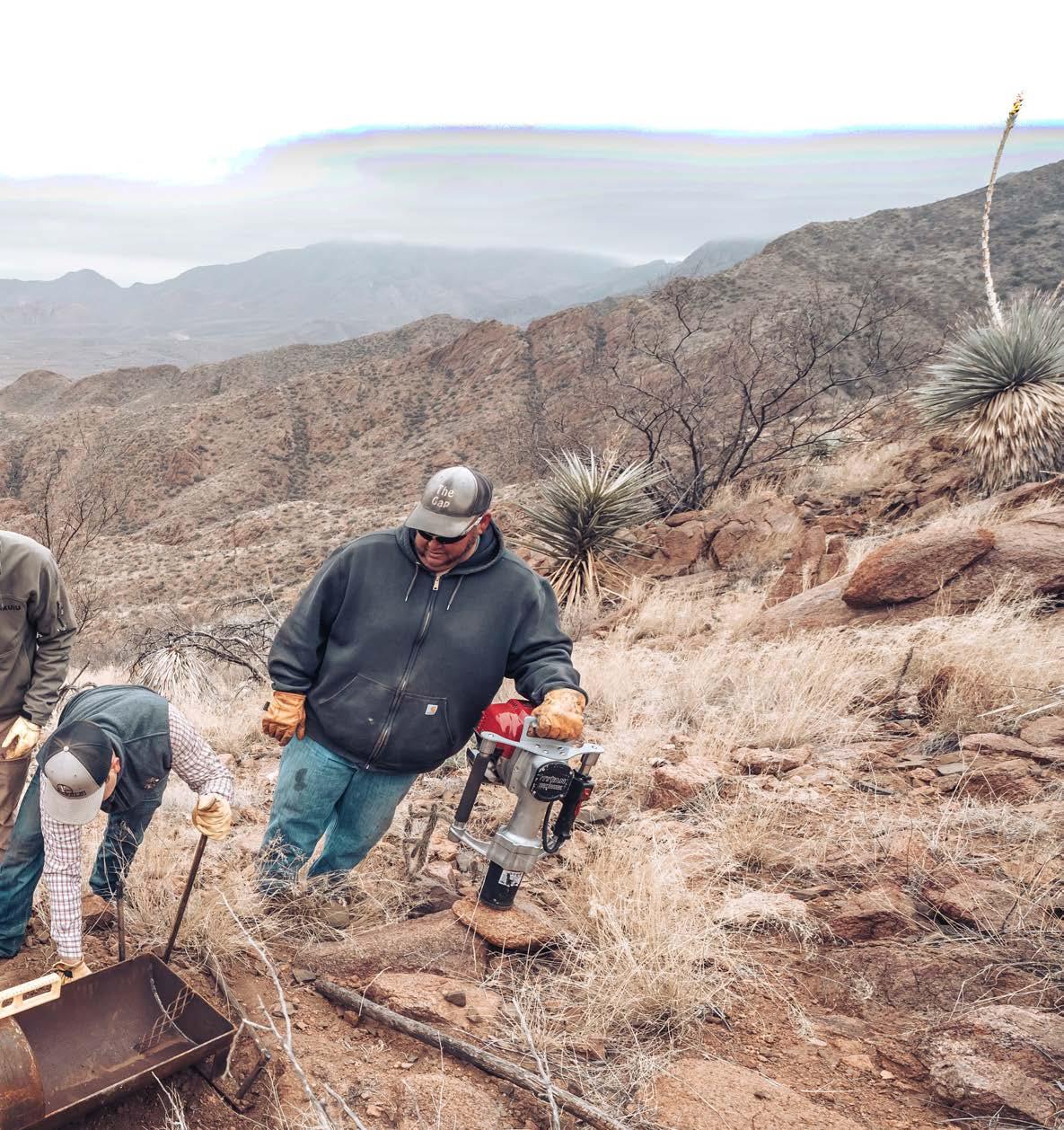

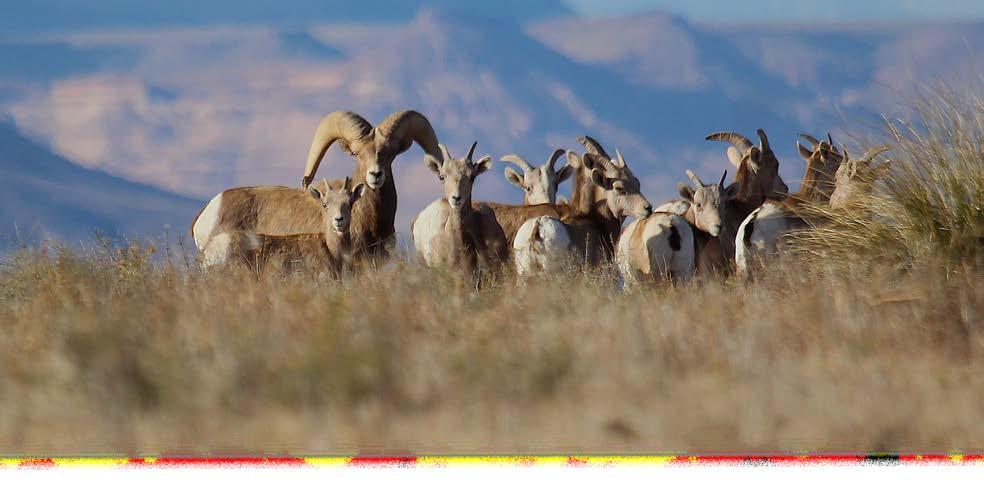

A large desert bighorn capture occurred at Elephant Mountain WMA near Alpine in December 2019.
Spearheaded by TPWD, it saw the capture of more than 100 bighorns to move to Black Gap WMA to the South. At the time, the Texas desert bighorn population was approximately 1,200, which was near historical levels.
A few months later, many of those were found dead as a massive respiratory disease event rocked Black Gap WMA. It was later found in Sierra Diablo WMA and on private lands. And it hasn’t stopped.
The 2023 fall count in Texas showed only 531 desert bighorn sheep counted in Texas.
“We had been disease-free for many years, so we were really concerned when we found the first dead animals, and that concern grew as the die-off continued and wasn’t isolated to one area,” said TPWD Desert Bighorn Program Leader Froylán Hernández
So, what happened?
TPWD officials believe contact with aoudad is to blame for the die-off.
ABOVE: Herd of desert bighorns in the foothills of the Elephant Mountain Wildlife Management Area. INSET: A captured ram awaiting release during the 2019 project.
Chester Moore
Courtesy
OPPOSITE: In Texas, aoudad are considered exotics so they have no regulatory oversight.
Courtesy Chris Stahl
Research by Texas A&M University shows that aoudad can transfer Mycoplasma ovipneumoniae (Movi), the deadly respiratory pathogen, to desert bighorns.
Aoudad are impressive, tenacious animals.
Males can reach up to 350 pounds and sport long, thick horns that curl back. They also have striking “chaps” of hair down their necks and front legs.
Hunters who have encountered the species talk about its incredible ability to evade detection and unrivaled stamina, while biologists marvel at its ability to reproduce and survive in hostile environments.
They are sexually mature at nine months old, have a 5.5-month gestation cycle, and usually have twins. Research from Sul Ross State University shows the harvest of ewes would have to be in the 80 percent range just to stop the population from increasing.
Also known as Barbary sheep, these are a North African native first imported into America via the New York Zoological Park and the Smithsonian’s National Zoo circa 1900.
In the 1940s, aoudad was introduced at the Hearst Ranch in California and McKnight Ranch in New Mexico. In the 1950s, TPWD officials released them into the Trans Pecos and Palo Duro Canyon in the Panhandle. In the 70s, translocations occurred in Pajaros Azules, Sierra Morena, and San Luis Potosi in Mexico.
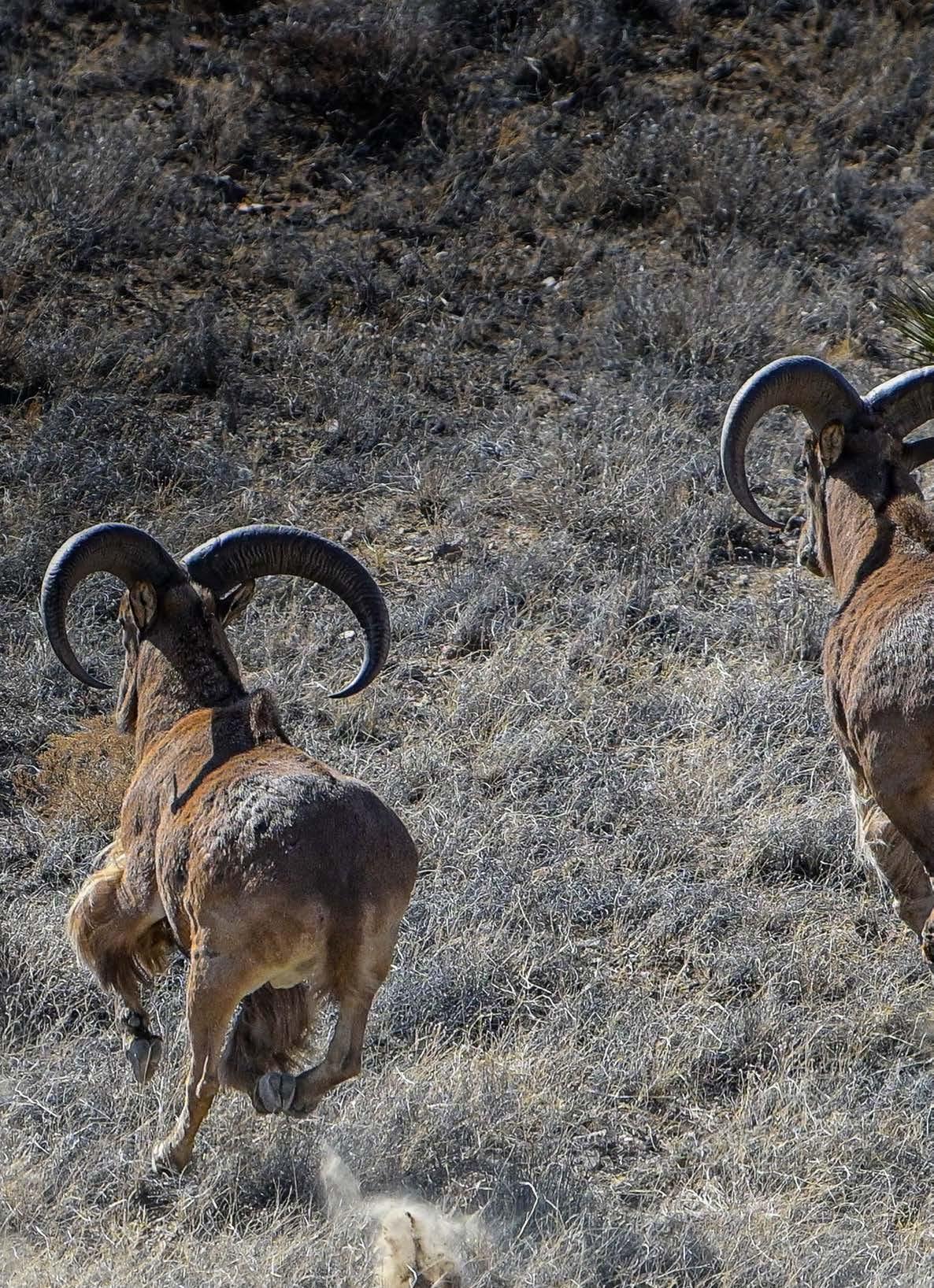
“BE SURE” is designed as a field guide to illustrate the differences between the species, especially where an aoudad can closely resemble a female bighorn sheep. It was produced by the Wild Sheep Foundation, in partnership with WSF’s New Mexico Chapter and WSF Affiliate Texas Bighorn Society. Scan the QR code for more information and instructions on how to get your copy of “BE SURE”.





“If you want to put in sweat equity for the sheep, we have opportunities to get involved in guzzler construction projects. We’ve also initiated an ‘adopt a guzzler’ opportunity to help maintain those structures. These kinds of projects offer a great chance to connect with the public on the cause of wild sheep conservation.” Sam Cunningham, WSF Board Member and Texas Bighorn Society President.
Materials and equipment were flown to two sites in the Franklin Mountain State Park ahead of the main crew of volunteers who installed two fully functional guzzlers providing water to all wildlife.
The goal was to offer a new species for hunters to pursue, and the stockings were highly successful in that regard.
Populations quickly flourished, and hunters were happy to pursue something so exotic and sheep-like. However, in the coming years, some wildlife managers would begin to see aoudad in a different light. As their numbers grew, concerns arose about their impact on native ecosystems, especially competition with indigenous species like bighorn sheep for food and habitat.
A 2018 TPWD survey showed 3,808 aoudad in three mountain ranges in West Texas compared to 1,500 desert bighorns in seven.
“We’ve seen 200 plus aoudad on a single mountain flying helicopter surveys,” said Froylán Hernández, TPWD Desert Bighorn Program Leader.
“They have taken a big foothold in the Trans Pecos that is very challenging from a management perspective, especially since Texas is 97 percent privately owned.”
In Texas, aoudad are considered exotics so they have no regulatory oversight. TPWD can and does conduct aoudad culls on public land.
“It’s a complex issue because aoudad hunting has become very popular, and since there is no season or bag limits and populations are high, there are
opportunities for landowners and outfitters to make substantial money, and we can’t fault them for that,” Hernández said.
Free-ranging aoudad hunts run from $5,000$10,000, and they are a virtually unlimited resource. Desert bighorn tags might go for a much higher price if they are issued on private land, but these tags are extremely limited.
Aoudad not only make for an impressive mount, but they are also a very challenging animal to hunt, which has given them an almost mythical status among many hunters in Texas.
“We know we can’t eliminate aoudad, and we’re not going to try, so we will focus on dealing with them on public land where we have leeway and communicating to landowners the value of bighorns and other native wildlife.”
According to Dr. Sam Cunningham, WSF board member and TBS President, the discovery of disease has taken the aoudad concern to a new level.
“Aoudad complicate things for our desert bighorns in Texas in a major way, and the situation inspires us to do even more to conserve our Texas desert bighorn populations,” Cunningham said.
In one study, researchers found that 100 percent of the aoudad populations tested across seven mountain ranges were positive for Movi. In one

“This is an important moment for desert bighorn sheep in Texas. WSF and its partners are fully committed to making a stand for conservation in the Franklin Mountains and ensuring this Texas native will exist and thrive in the state for generations to come,” said Gray Thornton.
specific range, the prevalence rate of Movi infection was as high as 65 percent, indicating a serious threat.
There are at least as many aoudad in Texas alone as there are desert bighorns in the United States.
That’s a sobering statistic that shows how complex the situation is regarding managing desert bighorns during the rise of the aoudad.
The Franklin Mountains represent excellent habitat for desert bighorns. The El Paso Community has embraced their restoration, which would be a symbolic victory with their return after more than 100 years.
“The people in El Paso are excited about plans to return bighorns to the Franklin Mountains, which are a popular area for hikers and other nature lovers. Public meetings have been held, and they have communicated a positive message about what we’re trying to do,” Cunningham said.
Equally important is the lack of aoudad. None of the exotics are currently in this range, and there
are no herds of domestic sheep or goats in the range either.
Franklin Mountains State Park could serve as a protected nursery herd that bolsters other mountain ranges in Texas as restoration opportunities become possible. States like Utah and Montana have nursery herds, contributing to numerous restoration projects within their borders and across the West.
This release could mark a much-needed fresh start for desert bighorns in a mountain range that has been long devoid of them.
In 1981, a group of hunters, led by the late Dr. James “Red” Duke, formed the Texas Bighorn Society, which set in motion a fantastic chain of events.
This includes in 1982-83 raising $200,000 to construct four 10-acre brood pastures in the Sierra Diablo Wildlife WMA to propagate bighorns donated from Nevada, Arizona, and Utah. Shortly lambs were being born at the facility, and the population was on its way back up the mountain.
These efforts caught the attention of C.G. Johnson, who in 1985 donated the 23,000 Elephant Mountain Ranch to TPWD to create a management area devoted specifically to bighorns. Two years later, 20 of them were moved from the Sierra Diablo facility to Elephant Mountain WMA.
Today, it serves as the epicenter of the species restoration in Texas.
Now, WSF and TBS are making a Texas-sized effort on the Franklin Mountains project, including installing two guzzlers there in March.
“When you have stresses on the herd as you have now, having access to water is even more crucial. Last year, TBS completed two guzzlers on private land in the Eagle Mountains, and we were excited to put these two in the Franklin Mountains in advance of the release this December,” Cunningham said. Guzzler projects can serve as an on-ramp for individuals to get involved directly with sheep conservation.
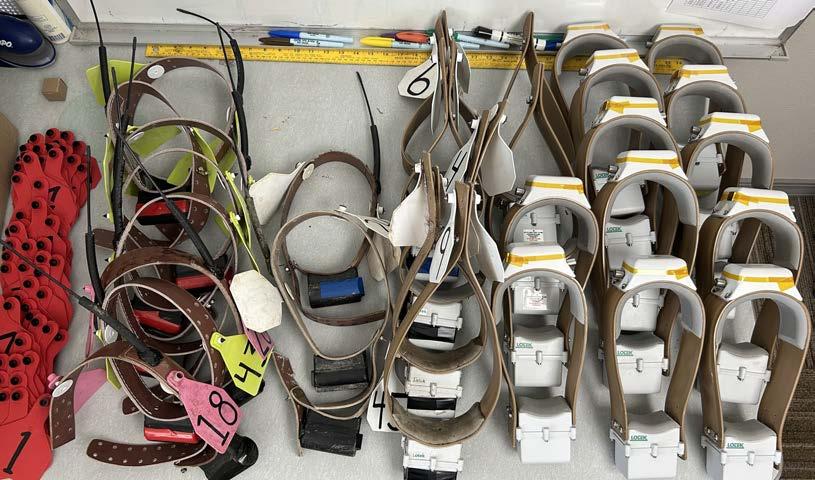
A portion of the funding for this project went to the purchase 80 ear tags and GPS collars, which will be deployed during the translocation.
Courtesy Scott Torland | ODFW
“If you want to put in sweat equity for the sheep, we have opportunities to get involved in guzzler construction projects. We’ve also initiated an ‘adopt a guzzler’ opportunity to help maintain those structures. These kinds of projects offer a great chance to connect with the public on the cause of wild sheep conservation,” Cunningham said.
WSF’s Women Hunt program alumni have adopted a guzzler at Black Gap WMA near the TexasMexico line. This conservation agenda will continue to seek similar support for structures in the Franklin Mountains and at many other locations in West Texas.
This project has also garnered strong media interest, appearing in WSF publications and mainstream media outlets in Texas. This could serve as a real awareness-raising opportunity for the species in the state.
Many Texans, including a fair number of hunters, are not aware of native desert bighorn sheep in Texas. The fact that most citizens never visit Texas’ extremely remote sheep habitat, coupled with the presence of so many exotic sheep like mouflon and even aoudad in many areas of the state, has caused confusion about the species.
There’s an ample opportunity for that to be corrected now.
Texans are big on bold statements.
And none was ever bolder than the way Colonel William B. Travis is said to have drawn a line in the sand at the Alamo, asking those who would stay and fight for the cause of Texas itself to cross the line and join him.
Faced with the challenges of disease and dwindling populations, WSF, TBS, and its partners have drawn their line—a commitment to ensuring these majestic animals survive and thrive in the rugged terrain of the Trans-Pecos region.
“This is an important moment for desert bighorn sheep in Texas. WSF and its partners are fully committed to making a stand for conservation in the Franklin Mountains and ensuring this Texas native will exist and thrive in the state for generations to come,” said Gray Thornton.
Just as Travis rallied his men to defend a cause they believed in, modern conservationists have chosen to fight for the bighorns.
They know the path is difficult but refuse to give up until desert bighorns are on the peaks of Franklin Mountains State Park and everything is put in place to keep them there.
W.B. “Burch” Carson
THE MISSION: Survey declining desert bighorn sheep populations in the rugged mountains of West Texas.
PROVISION: $125 monthly and expenses to feed two horses and three dogs.
That’s what W.B. “Burch” Carson accepted as he rode into the harsh country of the Trans-Pecos to catalog desert sheep populations for the Texas Game, Fish & Oyster Commission in the 1940s. Outside of wildlife biologists, Carson’s name is not well-known, but those who do know of his work regard him as a visionary and a legend.
“He not only provided some of the early recommendations for slowing the downward trend of desert bighorns in Texas but also emphasized the urgency in taking action,” said Clay Brewer of WSF and former Texas Parks & Wildlife Department Desert Bighorn Sheep program leader. Brewer said although desert bighorns eventually were extirpated from the region a couple of decades after Carson’s work, he positively impacted the species. “His work was important, and some things he said more than 80 years ago echo what we are contending with today.”

Carson was also an adventurer, taxidermist and character. That is evident in one of his creations, which is still popular at roadside gift shops. He would make shoulder mounts of jackrabbits with spike buck antlers to create a “jackalope.”
Although that ties in nicely with tall tales from the Lone Star State, the real story of Burch Carson is even bigger.
It is filled with adventure, hardship, and a call to conserve desert bighorn sheep for future generations.
SCAN TO READ THE FULL STORY.

C&A Partners: WSF Midwest Chapter
Funding Partners: Spatsizi River Outfitters, WSF Midwest Chapter, Anonymous Take One Put One Back donor
It was the greatest shot archery legend Fred Bear said he ever took. That recollection did not come lightly, as the bowhunting icon harvested everything from grizzlies to elephants in his storied career.
“I drew the 67-pound bow short, and let fly, trying to lob the arrow over the ridge and into the brisket of the ram,” Bear said.
What resulted was perfect shot placement on a massive 250-pound Stone’s sheep ram that sported a 40-inch curl and 27-inch spread. For many years, it stood as the Pope & Young world record, and it was taken in an area of British Columbia known as Spatsizi in 1957.

“Spatsizi” is a term from the indigenous Sekani language that means “red goat”. It refers to the local mountain goats’ behavior of rolling in the red dust of a specific mountain, which turns their fur red.
The region, however, is more known among mountain hunters for Stone’s sheep.
Bear’s massive ram was a striking example of the quality specimens from this remote wilderness area.
And it is the desire to continue the rich tradition of hunting there and conserving this resource that created a special Wild Sheep Foundation (WSF) Grant-In-Aid project.
Illustration of bowhunting legend Fred Bear lobbing an arrow at a Stone’s sheep ram, which held the top spot with Pope and Young for years.





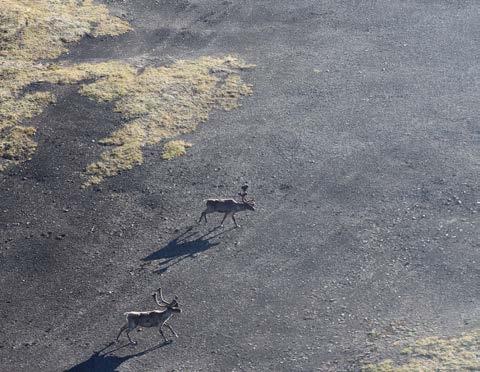
Inspired by a WSF call to be “bold for Stone’s sheep,” Spatsizi River Outfitters owner Mike Gilson fully donated a Stone’s sheep hunt to the Sheep Show auction in 2023.
This motivated WSF to donate 100 percent of the proceeds to a special project in Spatsizi Plateau Wilderness Park, which motivated an anonymous donor to kick in $100,000. The hunt sold for $120,000, and with the anonymous donation, the project had a strong seed of $220,000.
“After a visit with Gray Thornton and donating the hunt, I sat down to create a project with Bill Jex, BC Provincial Wild Sheep & Goat Specialist, Kevin Hurley, WSF Vice President of Conservation, along with Helen Schwantje, former BC wildlife vet and wild sheep advocate,” Gilson said.
The study’s initial partners were Spatsizi River Outfitters, WSF, Tahltan Nation, and the Province of BC.
“Others have since come on board, such as the Wild Sheep Society of British Columbia and the University of Alberta,” Gilson said.
Spatsizi’s remoteness makes it a truly special and unique destination for wildlife and hunters among Canadian destinations.
“Spatsizi Wilderness Park is completely roadless, with the only access being aircraft, horseback, or foot. Doing research within the park is more difficult due to the logistics involved in travel to and from the area,” Gilson said.
Despite the remoteness, all forms of pressure on Stone’s sheep have increased since the pandemic, from backcountry hikers and campers to mineral prospecting activities to hunting.
Phase One included an inventory taken in July 2023 in the Spatsizi Plateau Wilderness Park. During this aerial survey, researchers captured images Stone’s sheep (opposite) along with a wide variety of big game species.
Courtesy Bill Jex
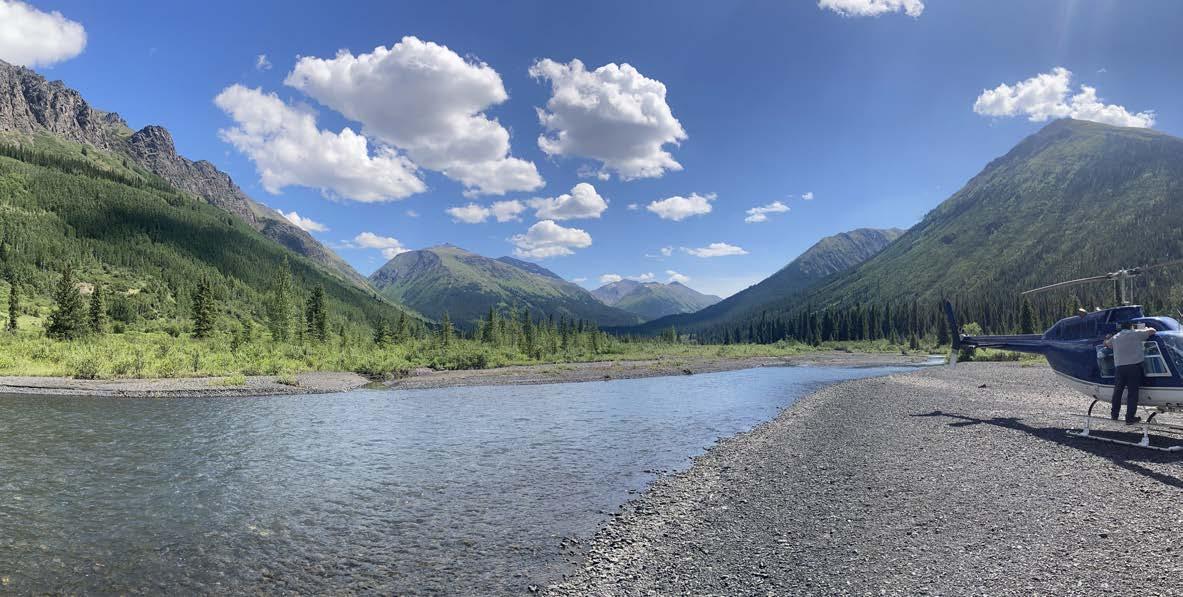
“The question arises: does increased access to the backcountry and modernized technology pressure sheep?”
Valerius Geist, the forefather of the North American Model of Wildlife Conservation, conducted some of the original surveys in Spatsizi in 1967. This early research remains the only comprehensive study conducted there, highlighting the need for updated assessments.

That’s when the last formal inventory of Stone’s sheep numbers in Spatsizi Park was conducted. Much can happen to an area this dynamic in two decades, making this research doubly important.
Since the park was established, the Stone’s sheep population has been managed through a combination of limited-entry hunts and guide quotas, aimed at balancing ecological sustainability with cultural and recreational interests. Not having a deep understanding of habitat issues and population dynamics has limited the ability to manage wildlife there.
Since little is currently known about this distinct population the goals of this project are as follows:
n Gather and analyze historical information and recent local knowledge, combining this with new data collected by the project. This approach will support the management of Stone’s sheep in the park and provide valuable insights for their conservation in the area.
n Compare the movement patterns of Stone’s ewes and rams with recent studies conducted in the Omineca, Cassiar, and Dome Mountain regions.
n Enhance the understanding of different migration strategies, such as geographic, altitudinal, or resident migration, as outlined in another
study. Where sheep spend their time, especially in winter, is an important detail.
n Examine the various migration strategies used by Stone’s sheep and how they differ.
n Evaluate health indicators, including body condition, to gain insights into the sheep’s use of seasonal ranges and behavior
Stone’s sheep are undeniably beautiful animals. Their coloration can range from gray to chocolate to almost black. These dark colors provide a stark contrast to the white on their belly, legs, and rump.
This coloring gives them incredible camouflage and amplifies the difficulty of hunting them in already intense terrain.
According to officials from the
“Spatsizi Wilderness Park is completely roadless, with the only access being aircraft, horseback, or foot. Doing research within the park is more difficult due to the logistics involved in travel to and from the area,” Gilson said.
BELOW: From Left to Right, Fraser MacDonald, Krystal Kriss and Gray Thornton ready to process, collar, and release a ewe under bitter cold but spectacular mountain conditions. BOTTOM: Spatsizi Team Members, from left to right, Lance Nagwan, Mike Gilson, Sean Whitford, Dr. Caeley Thacker, Krystal Kriss, Bill Oestreich, Gray Thornton, Fraser MacDonald, and Weston Creyke with last of forty Stone’s captured, processed, collared and released.
Courtesy Gray N. Thornton



British Columbia Ministry of Water, Lands and Resource Stewardship, Stone’s sheep occur only in BC and south-central Yukon. The vast majority of the population lives in BC.
They inhabit a vast range, primarily distributed along the interior slopes of the Coast Range, stretching from the Yukon border down to the areas near Mount Edziza and Spatsizi Plateau Wilderness Parks within the Stikine River drainage. From there, their territory extends into the rugged terrains of the Cassiar, Omineca, Muskwa, and the northern Rocky Mountain ranges, showcasing their adaptability to these remote and challenging landscapes.
The Pine River valley in British Columbia acts as a significant natural boundary, delineating the approximate dividing line between the habitats of Stone’s sheep and their relatives, the bighorn sheep.
This geographical feature shows the distinct ecological preferences and specific habitats favored by these two species, emphasizing their differing geographical ranges. The valley’s role in separating these species highlights the influence of natural terrain on wildlife distribution in British Columbia.
Ministry officials note that Stone’s sheep react predictably to seasonal changes in their environment, particularly the weather and the effects of weather on vegetation.
“Sheep respond to these changes by moving between traditional seasonal ranges in the way they learn from their elders. Despite being at home in their snowy northern environment, thinhorn sheep are poorly equipped to cope with snow. They do not have long legs to wade through snow, like moose or broad hooves to walk on top of it, like caribou, and for food, they rely on low-growing grasses and sedges that are readily covered by snow. They usually seek out treeless ranges with little or no snow cover.”
Bill Jex, BC Provincial Wild Sheep & Goat Specialist said Stone’s sheep are facing some of the same problems as their thinhorn cousins the Dall’s sheep are dealing with in Alaska.
Stone’s sheep are hit with multiple threats when it comes to predators – wolves, wolverines, golden eagles, and now mountain lions.
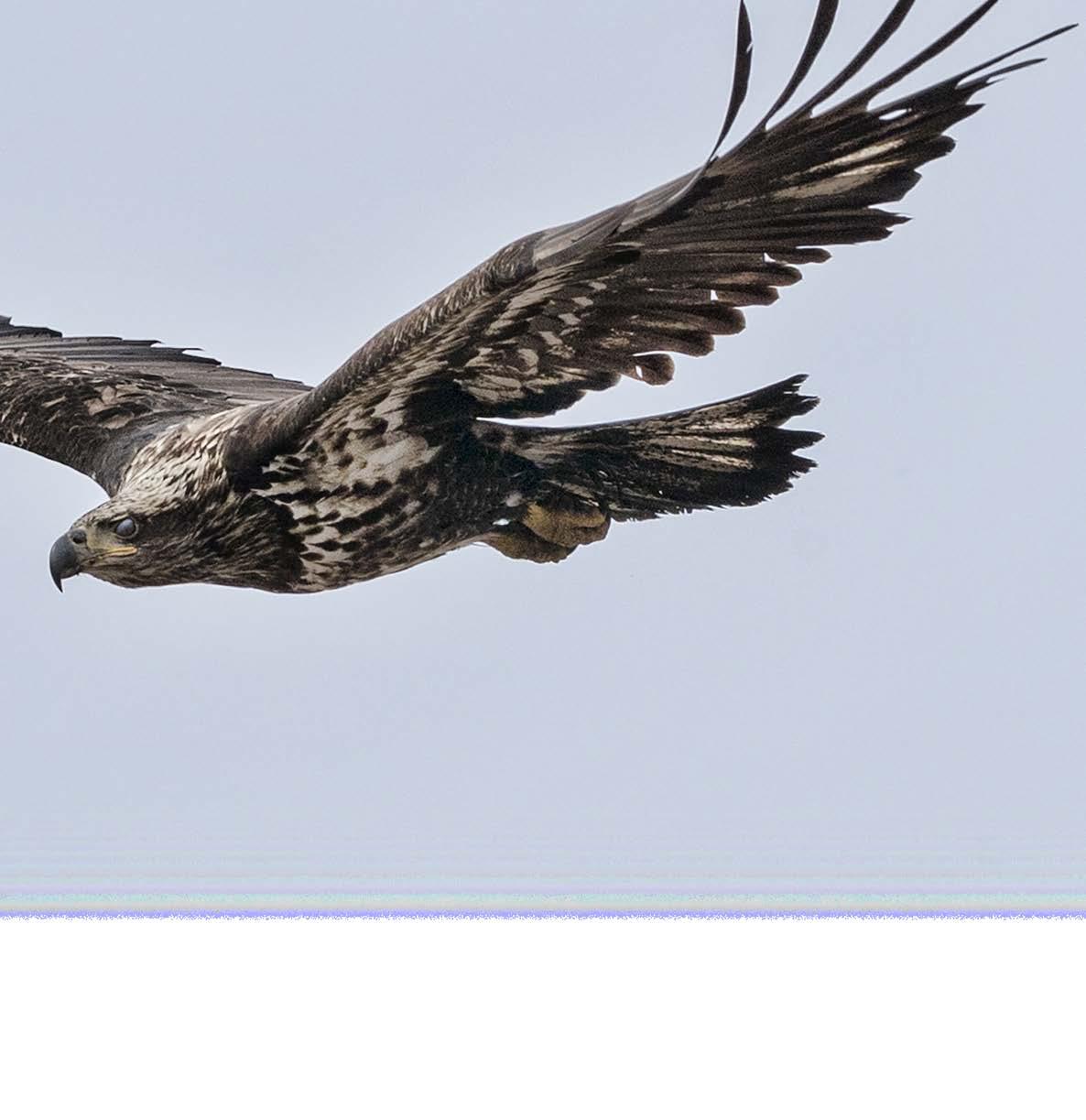
“I just finished working with a group of biologists on this issue, and we’re seeing the same patterns in weather and climate that impact Alaska’s Dall’s sheep,” Jex said.
“Some ranges have seen 30-70 percent declines in numbers. Province-wide, we’re probably 70 percent of where we were in 2010.”
Jex said the study will help with management decisions, as there is little data on wintering habitat, migration, and the use and location of mineral licks.
“This is why collaborations like this one with WSF and all of the people, agencies, and institutions involved are so important, especially here in Canada. We don’t have something like the Pittman-Robertson Act for funding, so projects like this really do make a difference,” Jex said.
These climatic changes, as well as road access for a variety of activities into Stone’s sheep territory, are causing additional problems with increased predation.
“For starters, the most aggressive predator on Stone’s sheep is the golden eagle, and their numbers are increasing,” Jex said.
Dramatic videos of golden eagles hitting thinhorn sheep and pushing them down mountains are all over social media. But according to Jex, the eagles don’t have to be successful on the first go-around.
“All they’ve got to do is get their talons in, and infection will set in, and the sheep will eventually die, and the eagle will find it,” he said.
Wolves are also a major predator, and the increasing number of deer and elk near Stone’s sheep pushes more cunning canines into their range.
“All
they’ve got to do is get their talons in, and infection will set in, and the sheep will eventually die, and the eagle will find it.”
Bill Jex, BC Provincial Wild Sheep & Goat Specialist
“Wolves are something Stone’s sheep have to deal with, and while they’re pretty adept at evading them in optimal habitat, they are at times vulnerable, and wolves will take advantage.”
A new predator is the mountain lion.
“Mountain lions are moving into parts of Stone’s sheep habitat, and these sheep have never had to deal with them. They’re having to learn about mountain lions, and although this is just really beginning, it will be interesting to see how it unfolds,” Jex said.
Mountain lions have been proven to become sheep-hunting specialists in certain areas. “Things are changing in the world of the Stone’s sheep.”
According to Gray Thornton, Phase 1 of the project was an inventory survey, more specifically, a summer habitat use review conducted in Summer 2023.
Dr. Caeley Thacker, far left, taking blood sample of ram with support of Fraser MacDonald and Weston Creyke. The Spatsizi crew conducted a full health assessment including throat and nasal swaps, blood, hair, DNA, and fecal samples, as well as a general body condition estimate of each Stone’s captured before collaring and releasing. FAR RIGHT: BC Ministry of Water, Lands, and Resource Stewardship’s Krystal Kriss (left) and Bill Jex (right) prepare collars and organize field health kits before capture gets underway.
Courtesy Gray N. Thornton

“Using dedicated funds, WSF purchased 40 GPS radio collars for the project’s Phase 2 plan to net gun capture, and conduct a full health assessment including hair, throat, nasal swab, blood, fecal samples, and ear biopsy. Then we ear tagged, collared, and released twenty ewes of varying age classes and twenty Class I to IV rams.”
Thornton, who was present for the capture, said it was amazing to see people coming together for the sake of Stone’s sheep. “It was a truly incredible experience. From Mike Gilson’s donation to everyone who has come together to start making big moves for this im portant game animal, it was awesome to see the capture, study, and release first-hand. It was an unforgettable experience, and it was the start of something special.”
It’s a bold step for a hunter to venture into a remote wilderness area like Spatsizi to pursue such an elusive game animal. Conserving them will require that kind of boldness moving forward.
“Spatsizi’s Stone’s sheep are in a place we know relatively little about from a scientific perspective. This project is already opening up understanding and will continue to do so,” Thornton said.
A powerful desire to hunt big Stone’s sheep has been alive and well for many years and is reflected in a statement in Fred Bear’s story of his record-breaking hunt.
“I’d come several thousand miles after a Stone ram, and I wanted a good one so badly I could fairly smell the chops cooking and see the mounted head on my office wall.”
Hunters today are no different, and the Stone’s sheep has emerged as the most prized wild sheep on the planet. There is no FNAWS pursuit without them, and the fact is that there are many unknowns about them in an ever-changing environment.
Stone’s sheep represent the pinnacle of wild sheep hunting, inspiring generations of hunters. As challenges in their environment grow, WSF and its partners remain committed to safeguarding these remarkable animals and the opportunity to hunt them.
Stone’s sheep are more than just a hunting oppor tunity or cash in hand for Gilson.
“The Stikine region of British Columbia, where our family-operated guide territories are located, was where guide outfitting in BC first began. Even in the beginning, the Stone’s ram was coveted by the early hunters. In the future, I’d like to see Stone’s sheep on the landscape for future generations to appreciate, as I’ve been able to.”
“If that is to happen, we must invest back into the sheep.” That is what being bold for Stone’s sheep is all about.


C&A Partners: Idaho WSF, Oregon WSF, Washington WSF
Funding Partners: Cabela’s Outdoor Fund, Eastern Chapter WSF
ARocky Mountain bighorn ram made a name for himself a few years back. Originally an Oregonian, the wander-lusting creature crossed the Snake River into Idaho and was captured and fitted with a radio collar. After that, he moved over to Washington, surprising even seasoned wildlife managers.
Moving across borders is not an issue for most wildlife, such as mule deer, for example. However, it can be deadly for bighorn sheep, as sheep infected with Mycoplasma ovipneumoniae (Movi) can transmit the deadly pathogen to other herds and cause mass die-offs.
In an article in the Lewiston Tribune, Frances Cassirer, lead bighorn sheep biologist and researcher for the Idaho Fish and Game, dubbed the creature the “Tri-State Ram” and noted that studying such behavior is crucial for understanding disease transmission.
“As neighboring states, we share sheep across these boundaries— they don’t recognize that imaginary black line. It’s exciting to work with our neighbors because we’re trying to meet the same objectives for this metapopulation.”
Don Whittaker, Ungulate Species Coordinator for the Oregon Department of Fish & Wildlife
Roaming sheep across shared borders and intertwined landscapes form the basis for the TriState Partnership. This multi-tiered conservation project seeks to not only share information and resources among agencies in relation to bighorn sheep but also help restore populations in the region.
The goal is to enhance the health of bighorn sheep populations through a collaborative effort involving three states, two tribes, the U.S. Forest
Service, the Bureau of Land Management, WSF, its Washington, Oregon, Idaho and Eastern chapters and the Cabela’s Outdoors Fund.
Current research focuses on understanding the factors that influence Movi persistence and management and on strategies for restoring bighorn populations after die-off events.
WSF committed a $220,000 Grant-In-Aid to a test and remove project to help clear Movi from the population and increase knowledge of this shared population of bighorns in a vast, rugged part of the country.
Test and remove projects involve the capturing of bighorn sheep, testing for Movi and euthanizing those sheep testing positive to stop the pathogen from spreading even further.
Each spring, large nursery groups form, and it takes only one ewe that chronically sheds pathogens to infect other ewes and lambs within the group. Chronic shedders can’t be identified by outward or clinical signs alone, so most adults need to be captured and tested to locate and remove the few individuals responsible for the persistently high lamb mortality.
“WSF wanted to upgrade our wild sheep conservation funding to include larger, landscape-scale projects. The ongoing Tri-State Partnership project
Bret Stansberry, IDFG Salmon Region Office, releasing a ewe after testing and attaching a radio-collar during the North Beaverhead capture, test, and remove project in Idaho.
Courtesy ID Department of Fish and Game





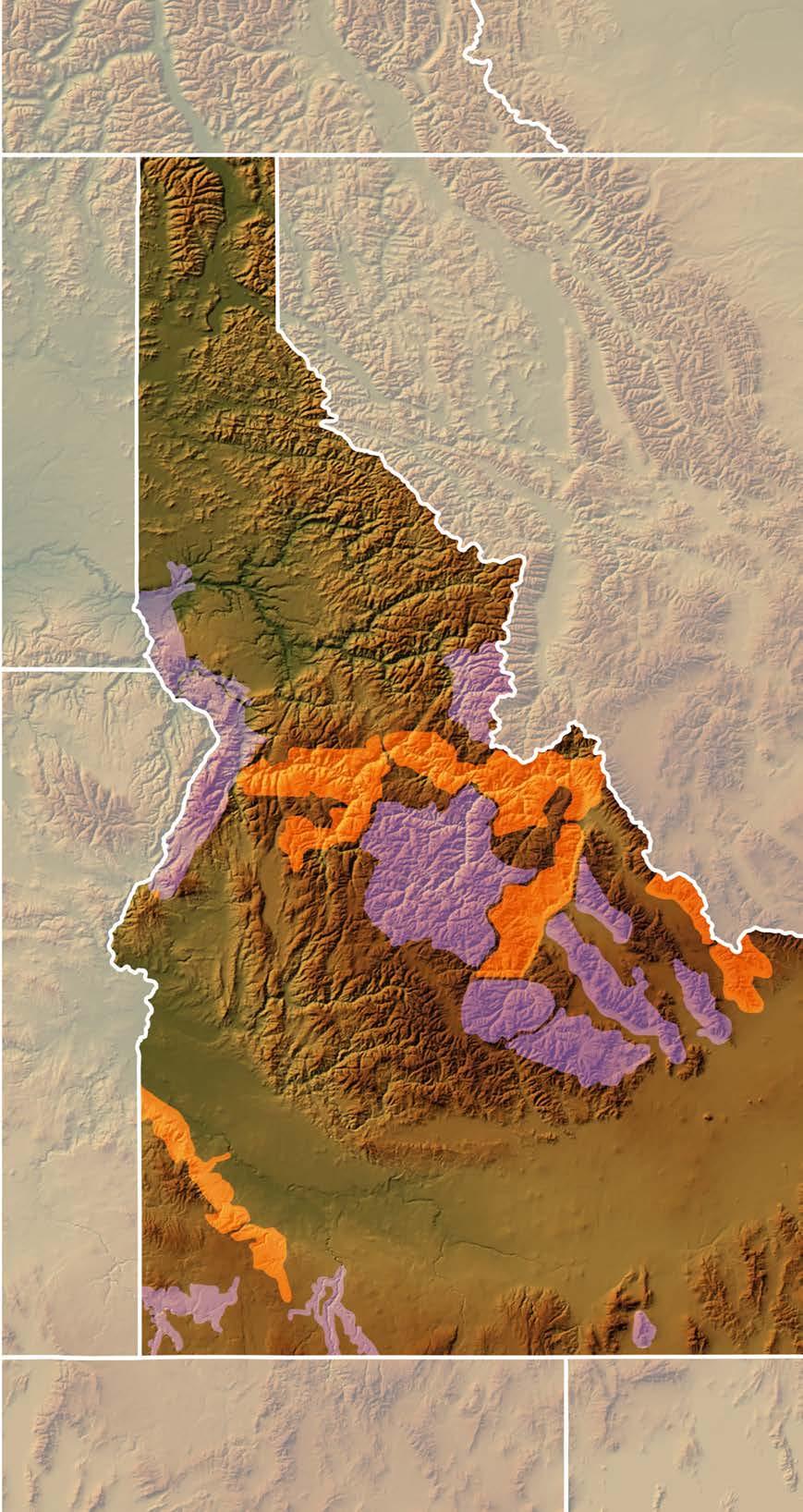
Number of radio-collars deployed on wild sheep in Idaho during the 2023-2024 Action Plan. This includes ground captures and, in some cases, recaptured animals that needed to have their collars replaced. Most lambs and some young rams were not radiocollared this capture season. Jan-Feb 2024
PMU that was part of Idaho’s 2023-2024 Action Plan



This map, figure, and photos reflect captured bighorn sheep from both the Tri-State Partnership along with a similar three-state effort further south, the ION Partnership (see page 36.)
Courtesy ID Department of Fish and Game

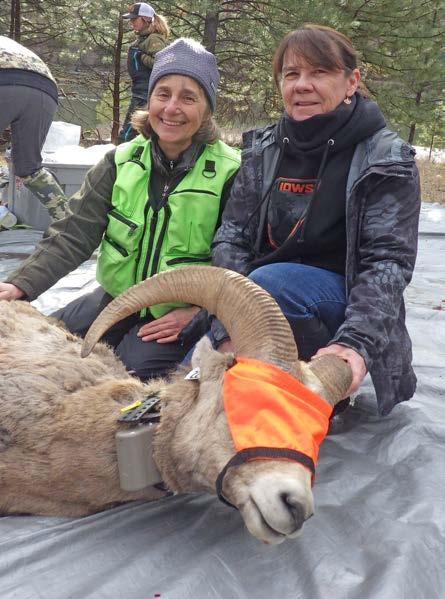

does just that, as management approaches are shared and coordinated across state lines,” said Kevin Hurley, WSF Vice-President of Conservation.
This area has a long history of record-class rams and major conservation wins, but the collective population is down 50 percent from just 20 years ago, and it just had a major setback.
According to Oregon WSF President Kevin Martin, in 2024, the project had to shift some of its attention to assessing and monitoring a new Movi outbreak detected in Hells Canyon in mid-December 2023.
“Historically, disease outbreaks in the Hells Canyon area have been observed spreading to various bighorn sheep populations across the Snake, Salmon, Grande Ronde, and Wenaha Rivers, as well as Asotin Creek,” he said.
These outbreaks are challenging not only for wild sheep but also for wildlife managers who truly care about the resource.
“Unfortunately, there is no way to treat animals to slow the spread of disease or reduce deaths,” said Frances Cassirer upon confirmation of the outbreak. “Our best option is to let the disease run its course over the next several months and then reassess the situation. At that point, our objectives are to restore the health of those affected populations and prevent further spread among the interconnected
This area has a long history of recordclass rams and conservation wins, but the collective population is down 50 percent from just 20 years ago, and it just had a major setback.
populations throughout Hells Canyon and the surrounding area.”
The latest report filed by the Tri-State Partnership at the time of this publication shows an extensive outbreak throughout much of the area.
In late June and early July 2024, Movi and pneumonia were first detected in two dead sheep along the Grande Ronde River in Washington. Previous detections in this outbreak, which originally started in Idaho in December 2023, had all been along the Snake River in Idaho, Oregon, and Washington.
The Tri-State Partnership’s report details that in June 2024, a ram in Wenatchee Creek (Mountain View) that died on June 27 tested positive for Movi, and a ewe that died on June 30 at Shumaker (Black Butte) also tested positive.
As the report explains, “Over the summer, Movi and pneumonia spread through Shumaker on the Grande Ronde and Mountain View. Unexpectedly, pneumonia seems to have skipped the lower Grande Ronde at and above Heller Bar (Black Butte) for the moment.”
Tri-State officials said the Washington Animal Disease and Diagnostic Laboratory (WADDL) continues to identify a single strain of Movi throughout the infected area.
In the partnership’s most recent report they noted that a group of five yearling rams, including two with collars, one captured in Wenaha in March and the other in Mountain View in November, moved south towards Enterprise in early July. They turned around and headed back north on July 10. However, due to concerns about possible contact with domestic sheep, the Oregon Department of Fisheries & Wildlife lethally removed two of the uncollared rams in the group on July 11 and submitted them for testing.
Fortunately, they were both negative for Movi infection and exposure.
Conservation is easy to connect with high-profile projects like species restoration through releases,

habitat enhancement, and long-term landscape protection. However, true scientific research has just as vital of an impact on conservation.
Research plays a critical role in wildlife conservation, particularly for species like the bighorn sheep that are prone to disease. Scientific studies serve as the backbone for informed conservation strategies and are the basis for much of the highly successful North American Model of Wildlife Conservation.
The seventh tenet of the N.A. Model is that “Science is the proper basis for wildlife policy and conservation.” That means research like that being conducted now among the three states in this conservation partnership is a must.
Understanding these animals’ diverse migration patterns, habitat use, and health indicators is essential for developing effective management
The harvest of mature rams serves as tangible proof of a meaningful investment in the Tri-State area. LEFT: During the 2022 season in Asotin County, Washington, WSF Summit Life Member Ryan Showalter harvested a remarkable bighorn scoring 184-3/8 B&C points. Along with the successful hunt, he appreciated discussing sheep management and the WSF’s conservation efforts with his guides. BELOW: WSF Summit Life Member Ben Rawls was recognized by the Wild Sheep Foundation’s Awards Committee with a Ram Award of Excellence – Rifle, as well as a Gold Award for his Oregon bighorn (196-5/8 B&C points) taken during the 2023 season in Wallowa County.
Courtesy Respective Hunters
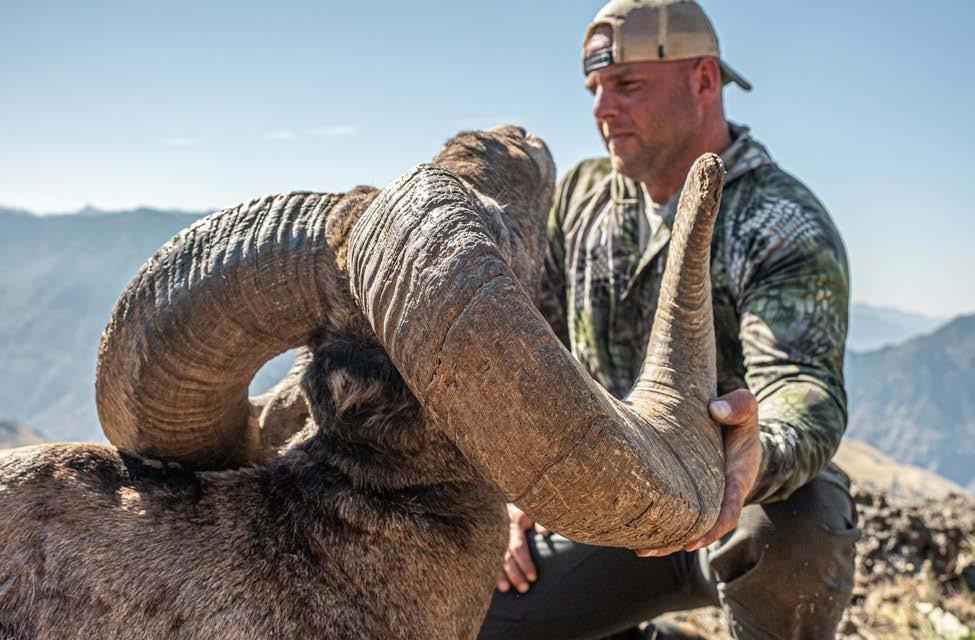

plans. Research helps identify threats to bighorn sheep populations, such as disease, predation, and habitat loss, allowing conservationists to address these challenges with data-driven solutions.
Research projects focusing on tracking movement patterns, evaluating health, and examining environmental impacts provide a comprehensive view of their needs.
At the time of this writing, a total of 844 bighorn sheep among the three states (713 ewes,
109 rams, 22 lambs) have been captured and sampled across seven populations. More than 550 GPS collars have been deployed, with about 400 currently active.
These studies highlight the current state of the population and predict how future climate or human activity changes might affect them.
“Research is so crucial to conservation, and that is why the Grant-In-Aid funding from WSF, the Washington, Idaho, and Oregon WSF chapters the Eastern Chapter, and industry partners is making a big difference, especially with what we have going on now,” said William Moore with the Washington Department of Fish & Wildlife (WDFW).
Moore said some of the funding is allowing Scott Peckham, who formerly worked for the
Confederated Tribes of the Umatilla, and now is a contract bio-metrician helping manage the data collected in the Tri-State project, to focus on community networking research on these herds.
“By understanding how the sheep interact and how herds may stay in one area or move to others, we can narrow down our scope of work and focus on that areas that need it most,” Moore said.
Recently, WDFW and the Tulalip Tribes started working together to evaluate the use of drones for monitoring bighorn sheep in south-central Washington.
According to WDFW this pilot research aims to assess the use of drones to collect bighorn sheep counts and whether drone survey data can improve the Department’s other surveys for bighorn sheep. Other project objectives are to assess whether signs of pneumonia infections can be reliably observed from drone imagery.
“If this works out, then maybe this technique could help survey some of the hard-to-reach areas in Hells Canyon, for example,” Moore said.
Additionally, predators always loom in the shadows and their impact on bighorn sheep herds is important. By collaring sheep, researchers can get an idea of various mortality rates, ranging from the impact of mountain lions and wolves to the prevalence of road kills which helps game and fish departments make policy decisions.
Mountain lions in particular can cause issues since they can become bighorn-hunting specialists.
This phenomenon and the management strategies used to contend with it are yet another example of the importance of research to conservation efforts.
Research is a form of wildlife conservation because it lays the foundation for proactive measures. Wildlife managers can adopt management strategies to ensure that these iconic animals continue to thrive in their natural habitats by continually expanding knowledge of bighorn sheep ecology through research in the Tri-State Partnership.
At the time of this writing, a total of 844 bighorn sheep among the three states (713 ewes, 109 rams, 22 lambs) have been captured and sampled across seven populations. More than 550 GPS collars have been deployed, with about 400 currently active.
“Due to the amount of sheep we have collared, we are in a unique position with this recent Hells Canyon outbreak,” said Don Whittaker, Ungulate Species Coordinator for the Oregon Department of Fish & Wildlife.
He explained most similar efforts have involved collaring only breeding-aged ewes, but the Tri-State Partnership has also put collars on plenty of adult and young sheep and that is giving them a different look than perhaps any other collaring study has had at this scale.
“We will be monitoring the herd and continuing the hard work that has been going on for several years here,” Whittaker said.
Tri-State Partnership officials continue to monitor the disease situation on the ground.
They anticipate the potential for an increased spread of pneumonia among bighorn sheep populations as the fall season progresses. This anticipated spread is primarily linked to the movements of male sheep during the rutting period.
To address this, they are planning a comprehensive initiative involving capturing, collaring, and testing more than 100 bighorn sheep.
This new effort will begin in October 2024 with ground darting, followed by helicopter captures scheduled for winter. Tri-State Partnership officials are committed to employing these measures to better understand the dynamics of this Movi outbreak and develop targeted interventions that will help sustain the health and resilience of the bighorn sheep populations in the region.
The wandering “Tri-State Ram” at the beginning of the story made a big splash in local media markets upon crossing into Idaho’s Clearwater River Valley.
Biologist Frances Cassirer told local reporters that the ram would have probably found more of its kind there years ago, but that herd has been gone for several decades.
This reality is sadly repeated throughout the West.
The test-and-remove strategy, along with other management principles, can perhaps set the stage for restoration in new areas in Washington, Oregon, and Idaho once issues are dealt with in Hells Canyon and beyond. And it is more important than ever since this latest Movi outbreak has occurred.
“As neighboring states, we share sheep across these boundaries—they don’t recognize that imaginary black line. It’s exciting to work with our neighbors because we’re trying to meet the same objectives for this metapopulation,” Whittaker said.
There is hope that one day, another healthy, wandering ram will go on a walkabout and find others of its kind, spreading its genetic potential and helping another herd’s viability.
This collaboration has translated into powerful conservation actions that are impacting Rocky Mountain bighorn sheep across this stunningly beautiful landscape.

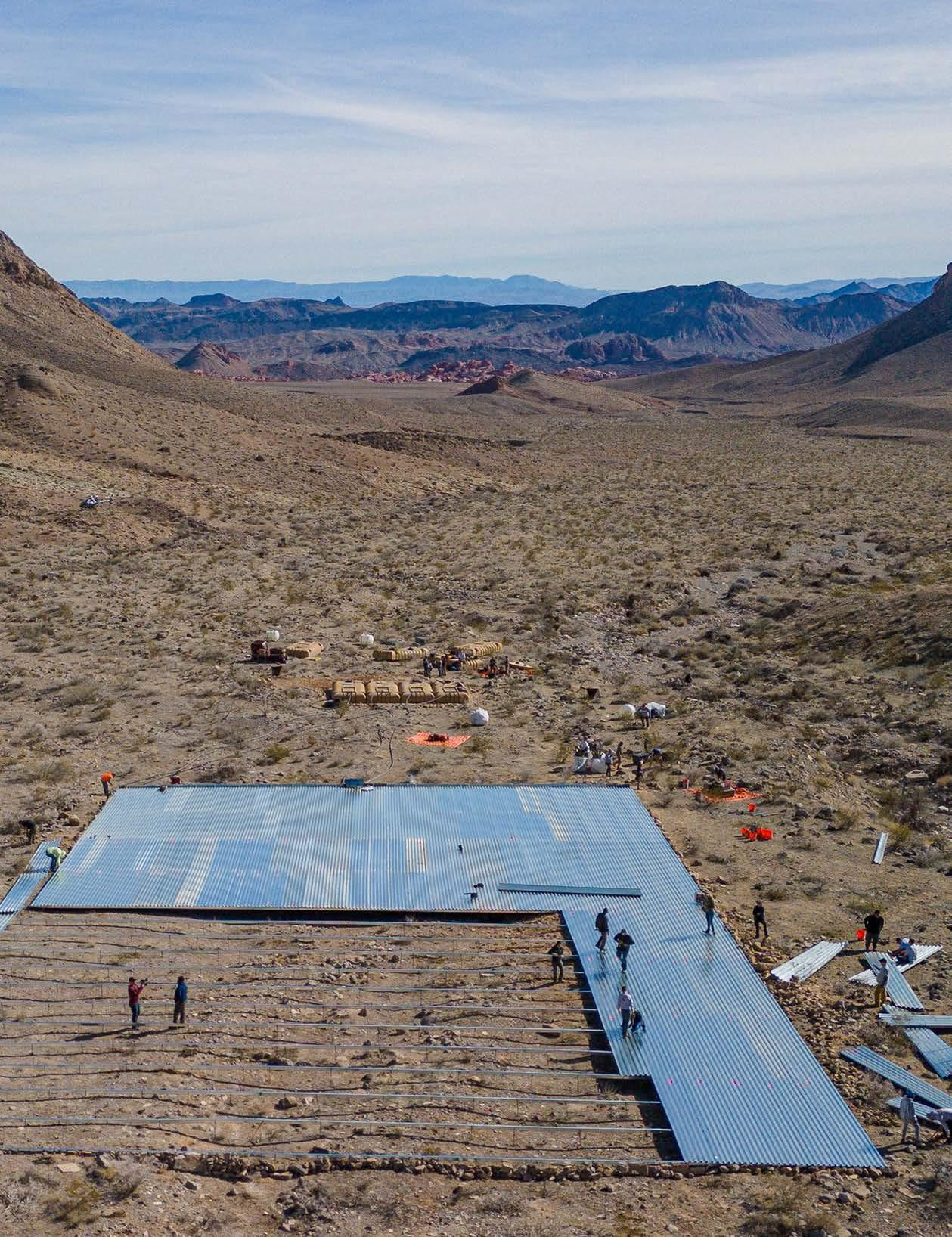
C&A Partners: Fraternity of the Desert Bighorn
Funding Partners: Bergara Rifles
Nevada is the driest state in the union, and Clark County, which includes Las Vegas and the Muddy Mountains within its boundaries, is the driest in the state. The Muddy’s are also home to one of the southwest’s largest desert bighorn sheep populations.
Extreme drought conditions in recent years significantly stressed the local herds and inspired hunter-conservationists to act.
Wild Sheep Foundation (WSF) matched a $30,000 grant from Spanish gunmaker Bergara to help fund a special guzzler project in the Muddy Mountains. The project also received funding from the Nevada Department of Wildlife (NDOW), WSF Affiliates Fraternity of the Desert Bighorn, Nevada Bighorn Unlimited Fallon, Nevada Bighorns Unlimited-Reno, and Meadow Valley Wildlife Unlimited.
“Guzzlers” are engineered devices designed to capture and hold water, dispensing it into drinking troughs that support desert bighorn sheep and other animals. In desert regions, accessible water is often limited to short seasons.
Periods of drought usually align with the late stages of lamb gestation and can impact survival of newborn desert sheep lambs.
“Successful wild sheep conservation is both preemptive and responsive. A drought-related die-off in 2020 sadly made clear the need for this modern-day water guzzler,” said WSF Marketing & Communications Director Keith Balfourd.
“The Muddy Mountains support one of the largest populations of desert sheep in Nevada.”
Balfourd said this undertaking is the largest guzzler ever built for water collection and distribution in Nevada’s history and it is already impacting wildlife.
Clint Bentley, Past President of Fraternity of the Desert Bighorn and WSF Board member said this guzzler is a
conservation milestone and technology has allowed for upgrades ranging from water conservation to servicing the device.
“We can check this guzzler’s water levels remotely, which saves a lot of time and lets us know when situations are critical,” Bentley said.
The Muddy Mountains desert bighorn herd is highly strategic because it has been free of Mycoplasma ovipneumoniae, the deadly respiratory pathogen that plagues bighorn sheep in many areas around the West. The 2020 die-off was not a disease event but a direct effect of drought.
“We can check this guzzler’s water levels remotely, which saves a lot of time and lets us know when situations are critical.”
Clint Bentley, Past President of Fraternity of the Desert Bighorn and WSF Board Member
Joe Bennett, NDOW’s Southern Region Game Supervisor, said one of the worst days in his career was when he was on a helicopter survey around a guzzler at the height of the drought and saw dead sheep.
“This is a great project, and we appreciate the NGOs that stepped up to help and to all the volunteers that came out to work. And we appreciate the Bureau of Land Management for their cooperation on this project, which will greatly benefit desert bighorn sheep in the now and the future.”
Nevada’s desert sheep population is around 7,000, and water development projects such as this new guzzler are helping secure their future. Hunters and other wildlife enthusiasts will benefit for generations to come from this investment in Nevada’s official state animal, the desert bighorn sheep.
Scan to watch the trailer for SITKA’s video about the Fraser River Project. Full length film coming out December 2024.


BACKGROUND: The netgunner’s view from the rear seat of a helicopter, right before the net is deployed to safely capture bighorn sheep. INSET: Net-gun capture crew collects blood and other biological samples from a freshly-collared bighorn,just prior to release back onto the mountain.
C&A Partners: Wild Sheep Society of British Columbia
Funding Partners: SITKA Gear Ecosystem Grant
Capturing California bighorn sheep along British Columbia’s Fraser River is challenging. Steep banks and rocky shorelines give the wary sheep an edge and places to hide from even the best helicopter capture teams.
An ongoing effort has seen partners unite to conduct successful captures, helping to reverse the decline in the region’s bighorn sheep herd.
“This is a long-term project that everyone involved hopes to see help the California bighorn sheep population in the rugged region reverse the trend of decline and get back toward historical highs,” said Kyle Stelter, CEO of the Wild Sheep Society of British Columbia.
Stelter said the population of the Fraser River bighorn sheep was the highest recorded in the early to mid-1990s, with more than 2,400 individuals. Sheep from this area are responsible for multiple translocations in Canada and the United States.
However, a respiratory disease outbreak in the late 1990s led to a significant die-off, especially among lambs, resulting in a steady decline in numbers. Today, the population has dropped to approximately 800 sheep.
Initially, managers attributed the die-offs to lungworm and other bacterial infections. Later tests confirmed Mycoplasma ovipneumoniae (Movi) in sick lambs.
Wild Sheep Foundation (WSF) Grant-In-Aid funds have contributed significantly here to bighorn sheep herd surveillance and management.
Phase 1 involved health sampling to map the distribution of Movi in the region. Phase 2 focuses on “Test and Remove” (T&R) treatments, where infected sheep are identified and culled, and the effectiveness of these treatments is monitored over time.
The wide distribution of Movi along the Fraser River underscores the need for ongoing treatments across the entire population to halt the pathogen’s spread and improve lamb survival.
Between 2020 and 2024, T&R treatments were implemented in nine bands of sheep. A total of 322 sheep were captured and tested, with 43 Movipositive sheep culled.
The results showed that lamb survival improved significantly following the removal of infected female carriers, with some areas witnessing up to a 600 percent increase in lamb-to-ewe ratios in some years.
On average, treated areas reported 47 lambs per 100 ewes compared to 13 lambs per 100 ewes in untreated areas, indicating a 262 percent improvement overall.
“The
difficulty of the terrain is making it hard to capture all of the ewes, so there are still some chronic shedders out there, but each area is being worked thoroughly. This project has made big strides for conserving California bighorn sheep here and will continue to do so.”
Stelter said the last complete Fraser region population survey was in 2020, but he is confident lamb recruitment and overall numbers will be up in the area when surveyed, most likely in 2025.
Kyle Stelter, CEO - Wild Sheep Society of British Columbia
“The difficulty of the terrain is making it hard to capture all of the ewes, so there are still some chronic shedders out there, but each area is being worked thoroughly. This project has made big strides for conserving California bighorn sheep here and will continue to do so.”
The very survival instincts that make this herd of California bighorn sheep challenging to survey are a testament to their resilience. These instincts have helped them survive disease outbreaks, predation, and other challenges.
WSF and its partners are unwavering in their dedication to helping this herd not only survive but thrive in the wilds of beautiful British Columbia.

C&A Partners: Idaho WSF, Oregon WSF, Nevada Bighorns Unlimited – Reno, Nevada Bighorn Unlimited – Fallon, Nevada Bighorns Unlimited – Midas, and Elk Bighorns Unlimited
“If I’ve learned one thing in 40 years of seeking the majestic wild ram, it is that hunting him is not a privilege to be taken lightly.” That statement written by legendary outdoor writer Jack O’Connor more than 50 years ago resonates today more than ever.
It is embodied in the Herculean conservation effort by the ION Partnership for the sake of the California bighorn subspecies in the shared range of Idaho, Oregon, and Nevada.
These partners know that complex, innovative work is required to sustain huntable bighorn sheep populations.
That’s why WSF and its partners, through its Grant-In-Aid, are funding a landscape-level project here that involves bighorn sheep captures, disease testing and removal of infected individuals, population surveys, predator control, and translocations.
Increasingly, wildlife managers agree that to manage bighorn sheep populations effectively, it is crucial to identify and remove adult individuals who are chronic carriers of the deadly respiratory pathogen Mycoplasma ovipneumoniae (Movi).
The challenge is that a few years after the initial outbreak, typically about five percent of the herd remains infected, which in particular impacts lamb survival.
The 2024 work year saw strong advancements in the project’s pursuit of this and other recovery goals, including work in new areas.
“For the last couple of years in Idaho, we’ve been building on a lot of areas, particularly around the Salmon River from Hell’s Canyon all the way up above the city of Salmon,” said past Idaho WSF President Bill London.
Idaho captured 22 California bighorns with zero removals, showing progress from recent work.
Nevada continued to test and remove with 49 captured and five removed but shifted priorities in some areas and also broke new ground.
“We backed off on test and removal in the Santa Rosas and Snowstorms and shifted to conducting a ton of ground surveys to assess subherd
lamb survival. We found out that we likely still have a chronic shedder in a couple of subherds to deal with,” said Mike Cox, Bighorn & Mountain Goat Staff Biologist with the Nevada Department of Wildlife.
“We reintroduced bighorn sheep to the Montana Mountains in March 2024. It’s an area that was pretty much wiped out by a severe pneumonia event in 2015.”
On the Oregon side, 57 bighorns were captured with no removals, and ongoing research shows the positive impacts of recent work.
“Due
to these efforts and funding support from WSF, Oregon better understands our populations in the ION Partnership area. Together, we have gathered information that we may not have been able to gather on our own.”
Kevin Martin, Oregon WSF
“Due to these efforts and funding support from WSF, Oregon better understands our populations in the ION Partnership area. Together, we have gathered information that we may not have been able to gather on our own. We are seeing improvements in multiple bighorn sheep populations across state and agency boundaries and next will be able to move our focus to those remaining populations in greatest need,” said Oregon WSF Kevin Martin.
These efforts will benefit the region’s wild sheep and sheep hunters for generations to come. Each tag drawn symbolizes a win for wildlife and the hunter-conservationists dedicated to securing its future.
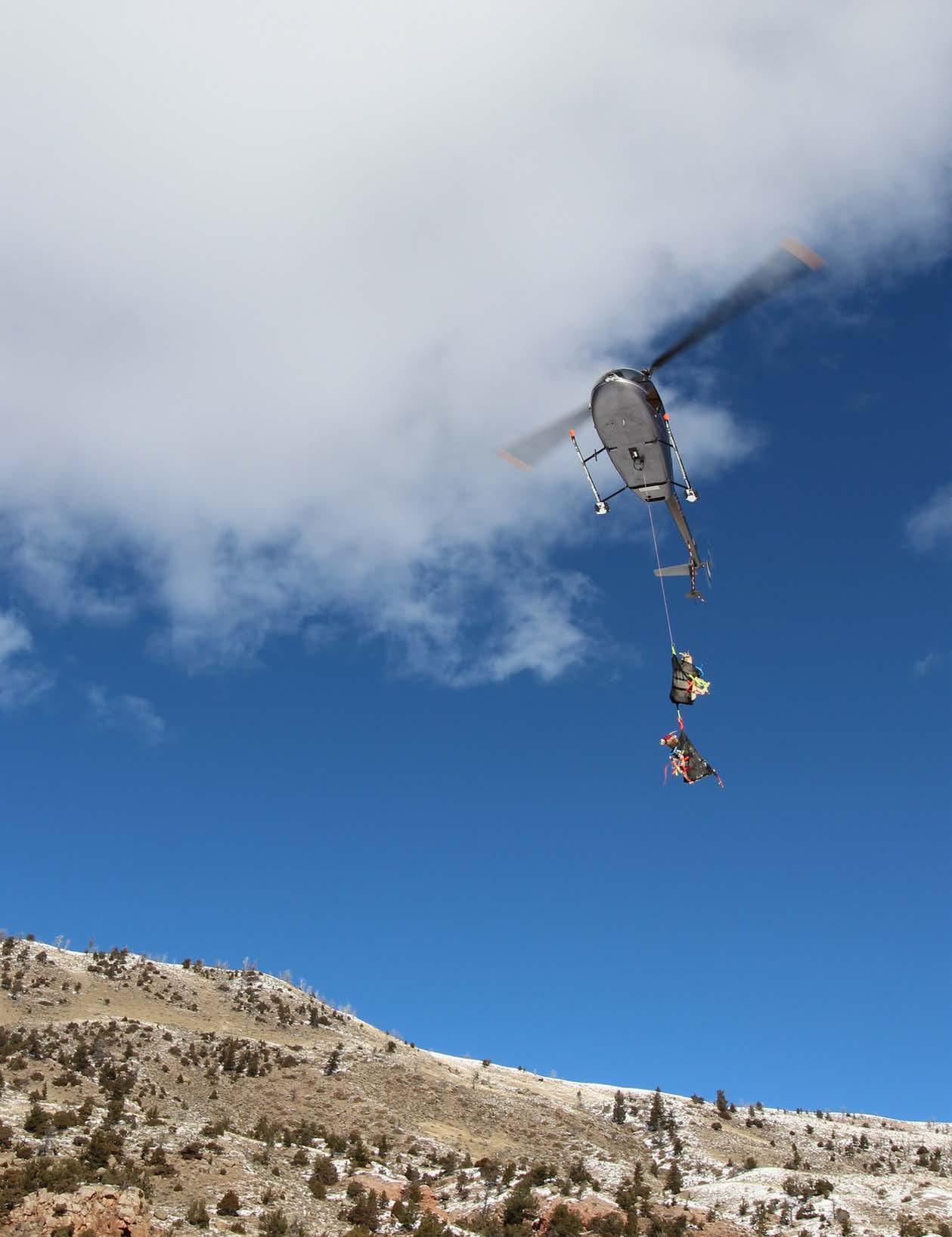
Assisted by wild sheep conservation volunteers and partner agency personnel, Wyoming Game and Fish Department staff led the effort to sample captured Whiskey Mountain bighorn sheep for respiratory pathogens.

C&A Partners: WSF Wyoming Chapter
Funding Partners: WSF Midwest Chapter
Atruly native herd of bighorn sheep is a rarity in the 21st Century. After the huge die-off that occurred beginning in the 1800s, translocating bighorns from one area to another was the means by which populations rebounded. As disease events bounced from one place to another in the coming years, this practice has continued.
That’s one thing that makes the Whiskey Mountain bighorn sheep (WMBS) herd of the northern Wind River Mountain Range in west-central Wyoming so special. These bighorn sheep are not only native but have helped other populations around the West rebound.
“The herd has been important in bighorn sheep management for Wyoming and other western states for many decades. Recognized for years as the largest congregation of wintering bighorn sheep in the country, the herd has been a management focus for the Wyoming Game & Fish Department (WGFD), federal land management agencies, and non-government conservation groups for over half a century,” said Katie Cheesbrough with the Wyoming WSF Chapter.
She said that from 1949 through 1995, over 1,900 bighorn sheep were captured and moved from the WMBS herd to establish new herds or augment existing herds throughout the West.
“At its peak, the herd provided substantial recreational opportunities for hunters and photographers.
Following a large, all-age die-off caused by pneumonia during the winter of 1990-1991, the bighorn sheep herd has consistently experienced low lamb production, leading to continued population decline.”
WGFD, in collaboration with the Eastern Shoshone & Northern Arapaho Fish and Game and the US Fish and Wildlife Service (USFWS), is extending the test and remove strategy to the eastern part of the Whiskey Mountain bighorn sheep herd.
This effort aims to reduce the chronic impact of Mycoplasma ovipneumoniae (Movi) on the herd. WSF provided $68,450 in partnership with the WSF Wyoming Chapter and WSF Midwest Chapter to purchase GPS collars and cover associated data costs.
WGFD is testing adult ewes and removing
those that test positive for Movi, with the goal of boosting lamb recruitment by eliminating carriers.
Additionally, data from the GPS-collared sheep will guide future habitat improvement projects.
“There is a lot of great research and efforts taking place, and we’re hopeful this will help reverse the longstanding decline in this historic herd,” Cheesbrough said.
The National Bighorn Sheep Center in Dubois, WY, was established in 1993 in large part due to its proximity to this herd.
“We’re honored to be able to educate people not only about the WMBS herd but the efforts of hunter-conservationist groups like WSF and the WSF Wyoming Chapter. They play such an important role in putting and keeping wild sheep on the mountain in the Wind River Range and beyond,” said Executive Director Amanda Verheul.
“Recognized for years as the largest congregation of wintering bighorn sheep in the country, the herd has been a management focus for the Wyoming Game & Fish Department (WGFD), federal land management agencies, and non-government conservation groups for over half a century.”
Katie Cheesbrough, Wyoming WSF Chapter
The facility impacts many travelers to Grand Teton and Yellowstone as well across the continent via monthly webinars with a positive message about wild sheep conservation that echoes from the home of one of the most historically significant herds in North America.


“To a dog, there is no such thing as ‘fresh air.’ There is just air that is particularly laden with information.” Canine researcher and author Alexandra Horowitz made that observation in one of her best-selling books, and it encapsulates why Working Dogs For Conservation (WD4C) is making strides on behalf of wild sheep.
An ongoing Wild Sheep Foundation (WSF) Grant-In-Aid project that included $28,750 in FY 2023-24 funding seeks to use highly-trained dogs to detect crucial information at bighorn captures-namely the presence of the deadly respiratory pathogen Mycoplasma ovipneumoniae (Movi).
“When we started this work, we didn’t know everything we didn’t know. It was uncharted territory,” said WD4C Executive Director Pete Coppolillo
Initially, it needed to be clarified how the dogs would detect Movi infections or how variations in infection indicators such as nasal swabs and ELISA (antibody) tests would affect their training and performance.
The dogs were trained on positive samples from wild sheep on both a nasal swab and an ELISA test. While this strategy led to high accuracy, it also significantly limited the pool of training samples.
In response, the team shifted to training with samples from only nasal swab-positive individuals.
This change was a “curveball” for the dogs, and their accuracy dropped considerably.
“Clearly, there’s a difference in the odor profiles. The dogs’ struggles helped us understand that,” Coppolillo said.
This led to adjustments in training protocols, and by early 2024, the dog’s performance had rebounded. Leo, a project veteran, achieved 100 percent accuracy in recent tests, while Fenton, a newer addition, hit 85 percent. Overall, the dogs averaged 83 percent accuracy.
During captures, each individual sheep is subjected to multiple swabs, with the later swabs containing much less material for analysis.
“To be blunt: there’s not a lot of snot left
at that point, so we had to adjust and help the dogs work at much lower concentrations of odor,” Coppolillo said.
The next phase involves effectively integrating this detection capability into wildlife management workflows. Each sheep population, manager, and capture operation is unique, necessitating a tailored approach to ensure canine detection methods align with specific objectives.
“When
we started this work,
we didn’t know everything we didn’t know. It was uncharted territory.”
Pete
Coppolillo, Executive Director Working Dogs For Conservation
“If we do that well, it’s my prediction next year we’ll be training a couple of Movi teams to ride circuit and provide their services to every capture operation that wants them,” Coppolillo said.
The team also plans to continue researching and testing non-invasive methods like scat detection which could in theory allow for habitat-level Movi detection.
“There is still work to be done, but WSF is excited to support this project,” said WSF President & CEO Gray Thornton.
“The ability to translocate wild sheep to new ranges with high confidence that we’re moving healthy sheep and not spreading disease along with them is crucial. In addition, if we can eventually detect infected animals without captures and handling, what we invest in these testing captures can be put to other uses, like habitat enhancements.”

Once captured via a net-gun deployed from a helicopter, bighorn sheep are blindfolded, hobbled, and slung to a central processing area for radiocollaring and pathogen sampling. A quick stop at a “dunk tank” helps cool these bagged and tagged bighorns.
Courtesy Justin Haag
C&A Partners: Iowa FNAWS
Funding Partners: Gilchrist Foundation
Nebraska isn’t the first place that comes to mind when thinking of bighorn sheep. Most people envision these majestic creatures on the high peaks of the Rockies or in the rugged deserts of the Southwest.
Yet, in the western reaches of Nebraska, beyond the fields of corn lie rolling hills, ancient bluffs, and wide-open spaces that are home to a small but resilient population of Rocky Mountain Bighorn sheep.
“Nebraska once had about 400 sheep in the state after several transplants, but with disease issues, our herd status is currently at about 250 total sheep,” said Todd Nordeen, Big Game Research and Disease Program Manager at the Nebraska Game and Parks Commission.
A Wild Sheep Foundation (WSF) grant-in-aid of $25,000 done with the Gilchrist Foundation is helping to conduct important research and translocations that could help the state’s herd return to former heights.
Researchers are currently focusing on understanding how Mycoplasma ovipneumoniae (Movi) affects its bighorn sheep populations. The main goals are to clarify how Movi impacts survival rates, determine if removing Movi-positive animals can lead to better lamb survival and test ways to detect it in the field.
The disease evaluation compares standard nasal swabs and ELISA tests with the detection abilities of Working Dogs for Conservation (WD4C). If proven as reliable as conventional testing methods, the use of these dogs could significantly reduce both the time and stress involved in testing animals during captures.
Nordeen said officials collected samples at the February 2024 capture that were integrated into the organization’s testing, yielding impressive results. See our WD4C feature for details.
Funding will also help collar and translocate sheep from their current range to suitable habitats
in other areas to strengthen population viability.
In 2024, WSF also stepped in to help Nebraska’s bighorn herd by writing a letter of support for a wildlife crossing project in the Wildcat Hills area, where numerous bighorns had been killed by vehicles.
Hunting is a critical component of sheep conservation in Nebraska, and annually, permits are issued based on population status.
“The Commission also approved an auction and resident lottery tag for 2025. The auction tag will be sold at the Sheep Show in January 2025.”
Todd Nordeen, Nebraska Game and Parks Commission
“We have two tags for the December 2024 season. The auction tag has been purchased, and the resident lottery tag was drawn back in the summer,” Nordeen said.
“The Commission also approved an auction and resident lottery tag for 2025. The auction tag will be sold at the Sheep Show in January 2025. Our first ever tag was in 1998, and we’ve offered, most years, one or two tags per year. By statute, if one tag is authorized, it has to go to Nebraska residents via lottery. If a second tag is approved, it can go through an auction,” Nordeen added.
Since the beginning of its program, these tags and WSF grant-in-aid initiatives have been a cornerstone of sheep conservation in Nebraska.
“WSF has been a part of Nebraska’s mission to re-establish sheep back in the state since 1981 when the first transplant took place after being extirpated from the state since the early 1900s,” Nordeen said.

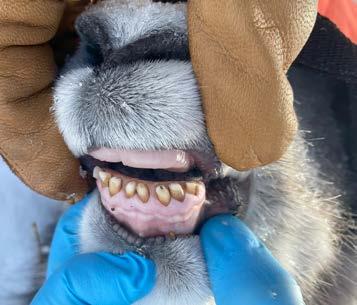
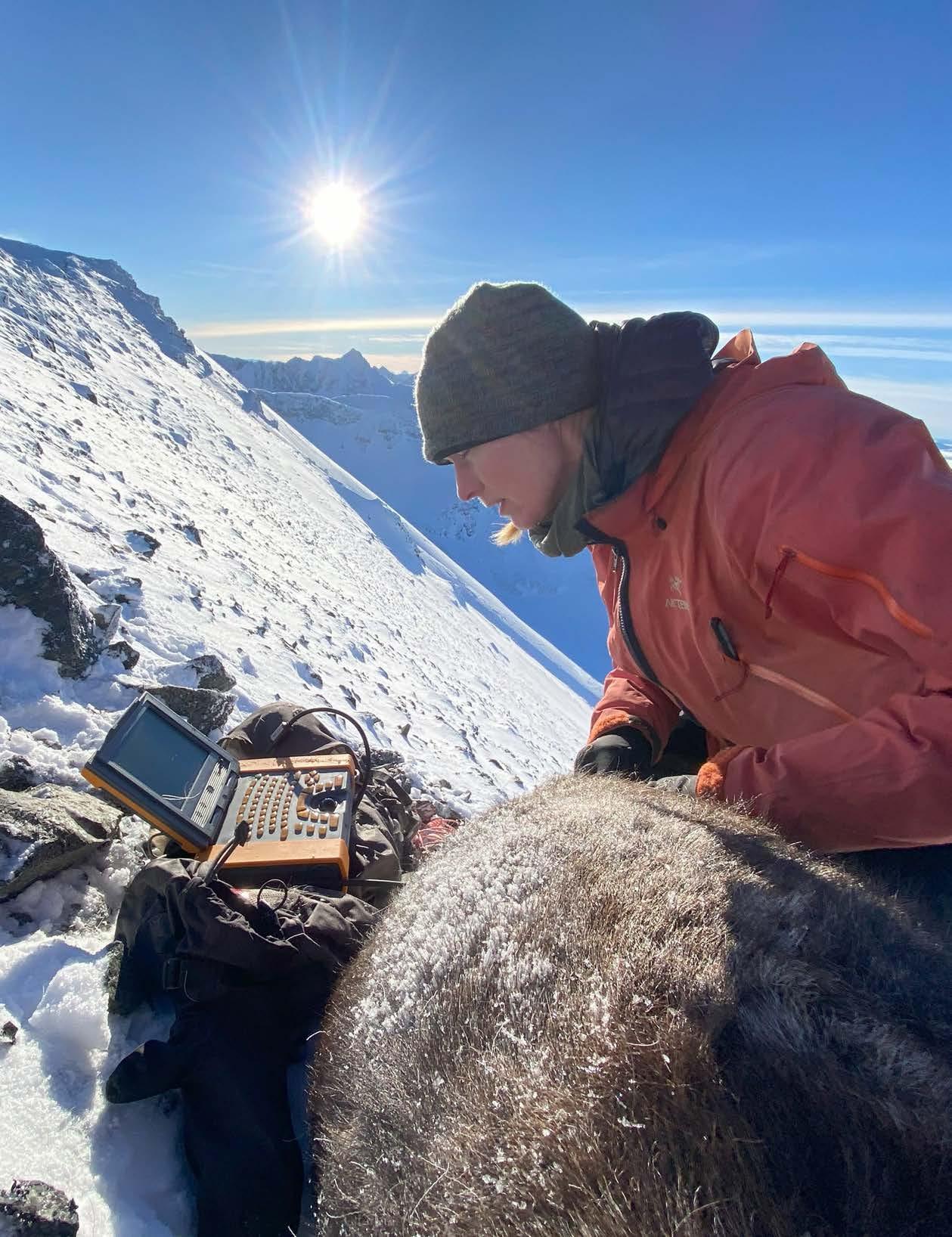
C&A Partners: Wild Sheep Society of British Columbia
Along British Columbia’s interior snowbelt lives a remote population of Stone’s sheep. These beautiful creatures, with contrasting dark bodies and light faces, are among the most iconic game animals in North America. However, they are also among the least understood.
A Wild Sheep Foundation (WSF) Grant-In-Aid contribution is helping wildlife managers learn more about these important mountain dwellers.
The study area of the Finlay-Russell ranges has seen a 50 percent decline in their population since 1993.
“This research aims to provide insights for conservation efforts and habitat management, ultimately supporting the long-term survival of Stone’s sheep in a dynamic area,” said Morgan Anderson, senior biologist with the British Columbia Ministry of Water, Land, and Resource Stewardship
The study’s primary objective is to monitor Stone’s sheep’s health, survival, and habitat use. This involves tracking herd dynamics, ensuring stable population growth, and assessing overall well-being.
“GPS tracking, along with other methods, is being used to map these ranges and study the sheep’s habitat selection, providing insights into their seasonal migration patterns and preferred environments,” Anderson said.
Additionally, assessing the quality of seasonal ranges during both summer and winter is crucial.
This includes measuring the availability and nutritional value of forage in different seasons to ensure the sheep have access to sufficient resources year-round. Body condition evaluations take place twice annually, once in late fall and again in late winter, to gauge how range conditions impact health and energy reserves. Based on these findings, the study will offer recommendations for habitat enhancement in areas where range conditions limit the sheep population.
The study has already identified some health risks to
the population, including the first recorded case of contagious orf (sore mouth) in Stone’s sheep.
“It’s not something that spreads through and can kill a population of wild sheep like Movi does, but it’s a concern because it typically comes from contact with domestic livestock. So we’re trying to figure out where it originated,” Anderson said.
Collaboration with First Nations is a central element of this project, as it incorporates traditional knowledge of where sheep roam and once roamed as well as cultural perspectives into the research.
This research aims to provide insights for conservation efforts and habitat management, ultimately supporting the long-term survival of Stone’s sheep in a dynamic area.”
Morgan Anderson, British Columbia Ministry of Water, Land, and Resource Stewardship
Additionally, the team is participating in community events like Science Week, held in Tsay Keh Dene Nation. During this event, the team will teach young students about wild sheep and the work being done to help them.
“WSF has made a big commitment to Stone’s sheep. The more we can understand them, the more we can invest in conservation projects that help keep Stone’s sheep and the rich tradition of hunting them alive and well in British Columbia,” said WSF President & CEO Gray Thornton.
Every sheep hunter has dreamed of heading into the mountains pursuing a mature Stone’s sheep ram. Initiatives like this help us better understand the numerous challenges these animals face in an ever-changing environment and how to preserve those dreams for future generations.

The Rocky Mountain bighorn sheep herd in Colorado’s San Juan Mountains is safer now. At the end of Summer 2023, the final grazing of domestic sheep on 10 public land allotments totaling 101,676 acres concluded, marking a huge win for wild sheep in the Centennial State. The project compensated domestic sheep permit holders to waive grazing rights, minimizing the spread of respiratory disease. As a result, Colorado Parks and Wildlife can now aim to increase the bighorn population, expand into unoccupied habitats, improve herd connectivity, and enhance hunting and wildlife viewing opportunities.
Grant-In-Aid Funding: $250,000 | Partners: Rocky Mountain Bighorn Society and National Wildlife Federation
Genetics is not just an emerging field in medicine but is becoming a crucial part of wild sheep management, ensuring the long-term health of herds. Concern over genetic bottlenecks in isolated populations impacting long-term herd health is growing among wildlife managers.
This project is focused on collecting blood samples from bighorn sheep throughout their range to establish a transcriptome bank for investigating gene regulation and disease. The funded segment of the project involves processing these samples to examine transcription patterns and their correlation with animal health outcomes. So far, 512 samples have been collected from various states, and transcription studies have commenced on samples from Nebraska, Idaho, and Utah.
Grant-In-Aid Funding: $60,000
Some bighorn sheep carry Mycoplasma ovipneumoniae but do not show symptoms themselves. This is dangerous to populations, particularly when ewes can transmit it to their lambs and others in nursery herds. This study focuses on two ways to manage disease in bighorns: hunting ewes and testing sheep to remove those carrying the disease. Over the past year, 110 adult females and 11 lambs were caught with two chronic carriers removed. This along with previous years research has led to significant insights on the role of body fat in immune system response to threats and the impact of ewe harvest and test and remove on herd health.
Grant-In-Aid Funding: $30,000 | Partners: Wyoming WSF
The Marco Polo sheep and ibex of Kyrgyzstan live in some of the world’s most remote areas, making research costly and difficult. This project is a testament to the power of citizen science, as it partners with outfitters and hunters to collect blood samples from harvested specimens. These samples are tested for antibodies to key pathogens, such as Brucella and sarcoptic mange, utilizing user-friendly test kits. Collaborators in Spain and Serbia assist in refining diagnostic methods, aiming to protect and sustain the health of Kyrgyzstan’s incredible wild sheep and goats.
Grant-In-Aid Funding: $30,000
The Dall’s sheep of the Yukon live in pristine, picturesque environments far from some of the developmentbased issues that impact bighorn sheep in much of their range. Disease, however, is a threat and one this longrunning project is studying.
Collaborating with the Yukon Government’s Animal Health Unit and Fish & Wildlife Branch sheep hunters get Mycoplasma ovipneumoniae sampling kits and receive training on the importance of collecting quality swab samples. Over 100 samples are collected and sent annually to the Prairie Diagnostic Services lab in Saskatchewan for analysis.
Grant-In-Aid Funding: $5,335.50 | Partners: Yukon WSF
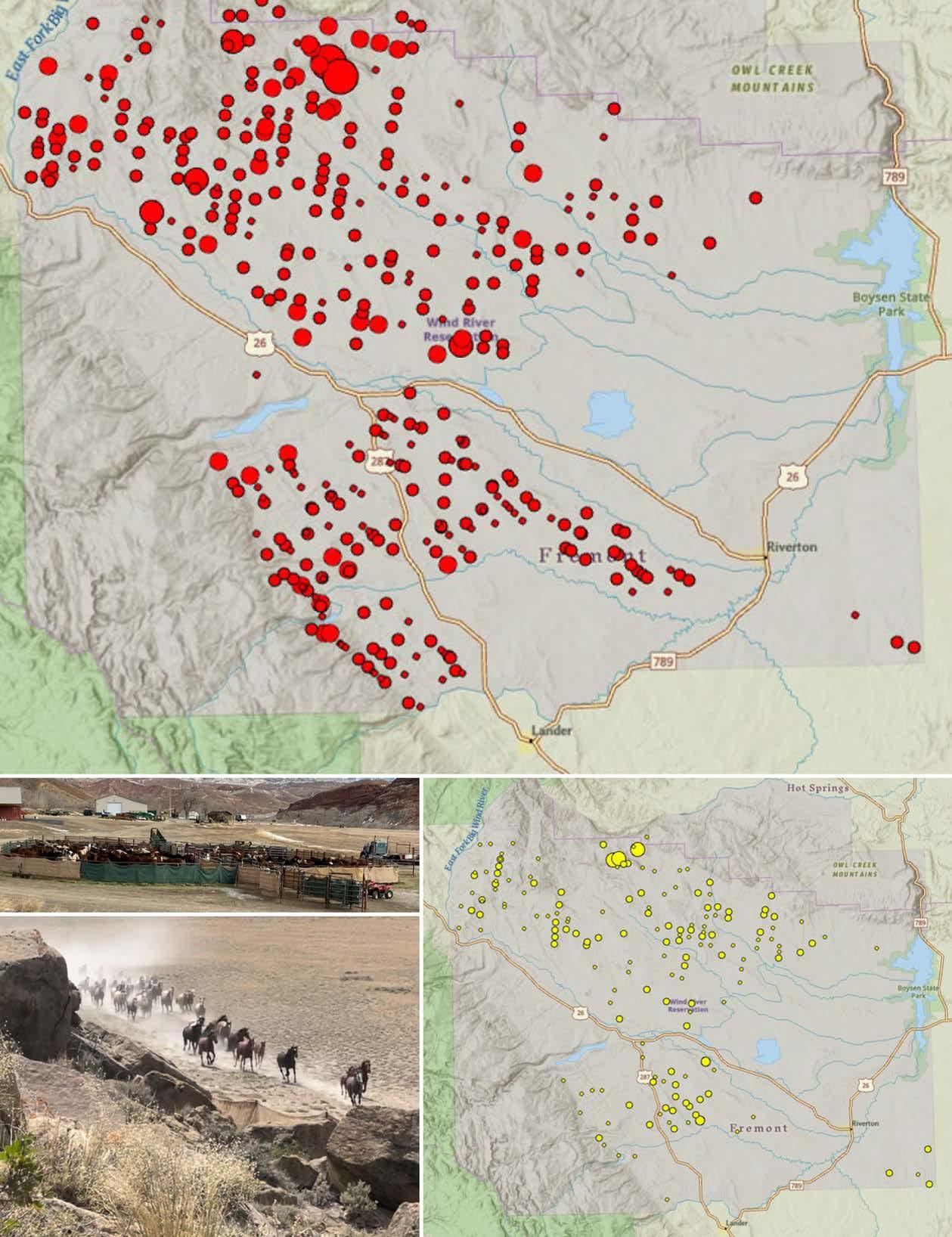
Red circles represent the number of feral horses counted in January/February 2022. Below, the yellow circles indicated the aerial count in October 2023 after 6,543 feral horses were gathered, leaving 1,289 on the landscape.
The presence of feral horses can cause significant damage to wildlife habitats. On the Wind River Reservation, a tribal-led initiative has made a big difference for both wildlife and habitat in this area of historic bighorn sheep habitat.
Through intensive aerial and ground-based roundups, 7,633 horses were removed, bringing the population down from an estimated 9,000-10,000 in 2022 to just 1,026. Tribal managers and members also played a role by conducting small-scale captures to support the project. Ongoing efforts to manage the situation include:
n Conducting additional aerial surveys.
n Hiring a feral horse manager.
n Continuously monitoring to prevent illegal horse dumping and maintain rangeland conditions
Grant-In-Aid Funding: $20,000 | Partners: Wyoming WSF, Shoshone & Arapaho Fish & Game Department
The aim of Wild Sheep Foundation’s contribution to this project is to conserve 1,292 acres of vital wildlife habitat in central Montana. This land is crucial for bighorn sheep, elk, and mule deer. It is adjacent to the Whiskey Ridge Conservation Easement, which enhances a larger conservation landscape. The easement also improves public hunting and other recreation access to 15,400 acres of surrounding public lands. Conserving sagebrush-steppe and mixed conifer breaks is essential for the Southern Missouri River Breaks bighorn sheep herd and that is accomplished with this easement.
Grant-In-Aid Funding: $5,000 | Partners: WSF Montana
One of Wild Sheep Foundation’s (WSF) objectives is to inspire a new generation of hunter-conservationists. That’s why it again supported the Montana Matters Youth Expo. Aimed at youth aged seven to 17, the program offers camps that provide mentorship from agency biologists and professionals annually and engages more than 200 young participants in scenic locations, such as Boone and Crockett Club’s Theodore Roosevelt Memorial Ranch and Magruder Ranger Station. A primary focus is wild sheep education. WSF helped sponsored the fundraiser banquet in Hamilton, Montana.
Grant-In-Aid Funding: $500 | Partners: WSF Montana


WSF sponsored the Northern Wild Sheep and Goat Council (NWSGC) at its 24th Biennial Symposium on Dena’ina land in Anchorage, Alaska. The event, titled “Recovering Populations in a Changing Environment,” focused on recovering populations in a changing environment. The scientific presentations and panel discussions were designed to cover a wide range of related topics.
The symposium aimed to promote the exchange of research, promote high standards in management, and provide expert advice on wild sheep and mountain goat conservation. It highlighted the importance of adapting strategies in the face of ongoing environmental change.
Grant-In-Aid Funding: $2,500 | Partners: WSF Alaska
WSF directed $2,500 to the Eastern Chapter of WSF for projects to be selected in Idaho and California, working collaboratively with its Idaho and California WSF Chapters. Both states are doing crucial work on wild sheep conservation. California is an important state for desert bighorns, and Idaho has populations of both Rocky Mountain bighorns and the California bighorn subspecies.
Grant-In-Aid Funding: $2,500 | Partners: Eastern Chapter WSF
From Fiscal Year 2016-2017 through Fiscal Year 2023-2024
Providing Horn Plugs to State & Provincial Game Agencies
Rocky Crate Chair for Wild Sheep Disease research – WSU
Fraser River, BC, California Bighorn Test & Remove
Bighorn Sheep Restoration in the Nebraska Panhandle
Prescribed Burns for Stone’s Sheep in Northeastern BC Tri-State Movi Test & Remove – ID, OR, WA
Chronic Carriers and Bighorn Population density/Nutrition
Field Detection Canine Disease Surveillance – WD4C
Sierra El Alamo Trap, Test, Transplant – Sonora, Mexico
Sierra El Alamo Water Development – Sonora, Mexico
CACI Pathogen Surveillance/ Disease Sampling – Central Asia
ION Partnership – ID, OR, NV

Feral Horse Removal – Wind River Reservation, WY
WAFWA WSWG Disease Management Venture
Movi Aoudad to Desert Bighorn Research – TAMU, Texas
Risk of Contact (RoC) Modeling
TOTAL FUNDING (USD) $81,107 $318,347 $280,000 $307,087 $471,000 $92,500 $85,000 $107,000 $105,618 $85,000
$105,000 $362,450 $25,000 $48,396 $53,000 $75,000


Without the financial support from sportsmen, fish and wildlife agencies would have little to no conservation and management programs dedicated to wild sheep. There is no other durable funding model, let alone one that has contributed at this level.
Whether you are a sheep hunter, hope to be, or want to see this opportunity for your children, this map is your legacy. JOIN THE
*TOTAL INCLUDES:
$1,377,655 - International $3,237,213 - Multi-State Projects
